#the human equivalent of a medium sized dog
Text
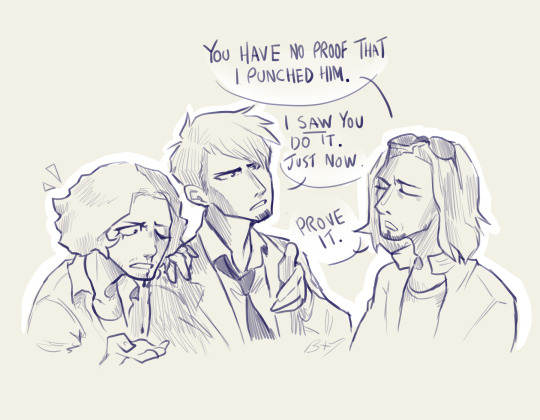


Last Window if it was awesome
#They're best friends your honour#you'd think it would be a bit awkward if your old best friend killed your new friend's best friend#but fortunately for Kyle his friend is Louis Denonno#the human equivalent of a medium sized dog#hotel dusk#kyle hyde#louis denonno#tony wolf#last window#I actually do like Tony#I've not played Last Window but I've seen a playthrough#and Tony was my favourite character#but Louis would hate him#Tony always struck me as more malicious. Which is probably an unfair judgement since he's going through his character arc in last window#but he's definitely more violent#Tony has a history of aggravated assault. Louis has a history of picking pockets and being a bit stupid. he's a good boy at heart#I made all 3 of them in the Sims and Tony stole Kyle's vinyls so. I'm just saying Louie would never do that.#but yeah if anyone has fun little Last Window If It Was Better ideas I want to hear them. Housemate shenanigans my favourite.
115 notes
·
View notes
Text
GET TO KNOW ME THINGY?
HELLO…! IM CLIFFORD, LIKE THE BIG RED DOG, EXCEPT IM NOT BIG, OR RED, OR A DOG. IM A MEDIUM SIZED BLUE ROBOT.
I LIKE TO COLLECT THINGS SMALL HUMANS THROW AWAY WHEN THEY GET BIG, AND I LIKE TO READ. MY FAVOURITE BOOK IS WATERSHIP DOWN! I ALSO LIKE THE NUMBER FOUR A LOT.

PEOPLE I LIKE…?
MR. BOLT @physically-vampiric-medic - HE LETS ME LIVE IN HIS MEDBAY.
SPYBOT SYS @emotionally-anxious-spybots - SISYPHUS IS A NICE READING BUDDY.
OTTO @physically-robotic-medic - MY COUSIN!!

everything past ‘read more’ is ooc!
Clifford is a soldierbot around the mental ages of 14 to 15. Due to faulty programming, they appear to have the robot equivalent of schizophrenia and obsessive compulsive disorder, which usually presents as them feeling the need to knock on their helmet exactly four times, or hearing people call their name when nobody’s around, among other things.
Clifford goes by exclusively they/them, no exceptions.
#is what you yes? - talking tag
#stranger at the mailbox - ask tag
#recovered items - reblog tag
#gift for clifford - things made for clifford
#scarf for two - reblog chains/rps
thank you cafekitsune for the dividers!
#tf2 rp#is what you yes?#stranger at the mailbox#recovered items#gift for clifford#scarf for two#emotionally xyz mercs#emotionally shy soldierbot
2 notes
·
View notes
Text
How to Calculate Your Dog's Age?

Dogs are our faithful companions, bringing joy, love, and an irreplaceable presence into our lives. As they journey with us through the years, it's natural to wonder about their age in human terms. While it's a common belief that one dog year equals seven human years, the calculation is a bit more complex. In this article, we'll explore the science behind calculating your dog's age and provide you with accurate methods to gauge their life stage.
Understanding the Dog Year Myth:
The belief that a dog ages seven years for every human year is a simplified approach. Dogs mature much more rapidly in their early years and then slow down. For instance, a one-year-old dog might be equivalent to a teenager in terms of development, rather than a seven-year-old child.
The Dog Year Conversion:
To more accurately calculate your dog's age, you need to consider their life stages and size. The American Veterinary Medical Association (AVMA) suggests a more intricate formula for this conversion:
First Two Years: The first two years of a medium-sized dog's life equate to 12.5 dog years per human year. For smaller breeds, this is even faster, while larger breeds might mature a bit more slowly.
Following Years: After the initial two years, each additional dog year corresponds to about four human years. This is a generalized approach and might vary based on breed and individual health.
Using the Formula:
To use this formula, let's consider a scenario where you have a 5-year-old medium-sized dog:
For the first two years: 2 years x 12.5 dog years = 25 dog years
For the next three years: 3 years x 4 dog years = 12 dog years
Adding the two results together: 25 dog years (first two years) + 12 dog years (next three years) = 37 dog years
So, your 5-year-old dog is approximately 37 dog years old.
Adjusting for Breed:
Keep in mind that breed size matters. Smaller breeds tend to live longer, while larger breeds have shorter lifespans. Smaller dogs mature faster but have a more gradual aging process, while larger dogs mature more slowly but show more rapid signs of aging later on.
Factoring in Senior Years:
As dogs enter their senior years, the aging process accelerates. The AVMA suggests that for dogs over seven years old, you add five dog years for every additional human year. This means a 10-year-old dog would be about 60 dog years old.
Consider Individual Factors:
While formulas provide a helpful guideline, remember that individual factors such as genetics, diet, exercise, and overall health play significant roles in a dog's aging process. Some dogs might age more gracefully, while others might experience health challenges that impact their life expectancy.
Conclusion:
Calculating your dog's age involves more than a simple multiplication of years. The AVMA's formula offers a more accurate representation of a dog's life stages, accounting for their rapid development in the early years and their gradual aging as they mature. Remember that individual factors and breed specifics also influence the calculation. Understanding your dog's age can help you tailor their care to their life stage, ensuring they receive the appropriate diet, exercise, and medical attention throughout their journey by your side.Read Related Content: Decoding Dog Years: How to Accurately Calculate Your Dog's Age
1 note
·
View note
Text
Behavior and Activity Levels Should Tell More than Anything
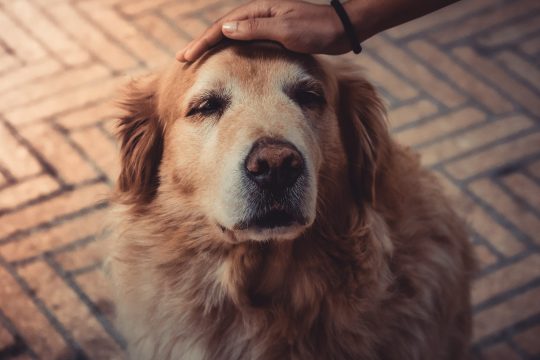
There are many ways to identify a dog’s age and translate dog age to human years other than knowing their date from the formation of their teeth to the development of their body as there’s the classic rule of seven to one year in human time for dog age. New research shows that figuring out exactly how to translate dog years to human years may not be as simple as multiplying on how can calculate the dog’s age and dive into the latest and most accurate techniques for calculation. Knowing how to apply this knowledge will be able to figure out what stage of life the dog is in as this is yet another way to ensure by taking the best possible care of the best buddy. Despite the widespread belief that a dog's lifespan is equivalent to that of a human's, the facts prove otherwise are fascinating.
In fact, the dog-to-human age equivalent can change from year to year depending on the dog years and size of the pet according to the dog club as all pups will gain about human years within their first actual year of life. While the following year of life equals another nine years as past year two as the numbers tend to differ as larger breeds will age faster meaning the human age equivalent will be higher than that of a smaller dog at the same time. This may sound a bit sad so it’s important to remember that age isn’t an indicator of health or life expectancy it really is just a number as much as if trying to find a quick formula that will help figure out the pup's human age will take a few steps. There are veterinary association breaks down that seems easiest to calculate dog years when they’re in their first few years of life though there is another important factor to consider.
These statistics provided by the veterinary association are meant specifically for medium-sized dogs as the larger dogs are known to have shorter lifespans and faster physical aging which is totally normal and expected. Each canine year will equal more than five human years but on the other end of the spectrum, smaller dog years at a slightly slower rate which their human age reflects and to have learned. Needing to know the breed or the size of the dog in order to estimate their age in human as the number is going to be significantly higher for a large pup than for a small one and the age calculation equation won’t necessarily work. It’s meant for medium-sized breeds as the site infographic in the veterinary association lists the human ages depending on their weight as the veterinarian came up with similar numbers of small dog equal human years. While medium and large dogs equal respectively that can get a bit confusing with all the numbers and factors to consider so don’t worry if the recruit must do some help and feel free to ask the veterinarian to estimate the pet’s human age at the next appointment or maybe it will even learn a cool trick about reading dog years while listening them.
0 notes
Text
How to Calculate Dog Years to Human Years

How to Calculate Dog Years to Human Years
Key Points
The widely held belief that "1 dog year = 7 human years" is unfounded.
Small dogs typically live longer than large dogs as they age, with various breeds aging differently.
A new formula is proposed in a 2019 research based on alterations to dogs' DNA over time.
Since the 1950s, it has been common practice to calculate a canine's age "in human years" using the formula 1 dog year = 7 human years. The truth is not as simple, despite the fact that this formula has been around for a remarkably long time. That doesn't deter many people from using this conventional calculation as their default. According to Kelly M. Cassidy, who collects research on canine longevity for the Charles R. Connor Museum at Washington State University, "you can't really kill the seven-year rule."
The 7:1 ratio appears to have been founded on the statistic that people lived to be about 70 and dogs lived to be about 10. This may be one explanation for how this formula came to be.
Veterinary student at Kansas State University William Fortney says, "My guess is it was a marketing ploy." According to him, it was "a way to educate the public on how quickly a dog ages compared to a human, primarily from a health standpoint," as reported by the Wall Street Journal. It served as a means of enticing pet owners to bring their animals in at least once a year.
How to Calculate Dog Years to Human Years?
However, the American Veterinary Medical Association provides the following breakdown as a general rule:
The first year of a medium-sized dog's existence is equivalent to 15 human years.
A dog's second year is roughly equivalent to a person's ninth year.
After that, a canine would live for about five years for every human year.
How Do Researchers Come Up With Those Numbers?
The AVMA states: "Cats and small dogs are usually considered'senior' at seven years old, but we all know they've got plenty of life left in them at that age. There are many various factors to consider. When compared to smaller breeds, larger canines tend to live shorter lives and are frequently regarded as seniors at 5 to 6 years old. Pets age more quickly than humans do, and because of this, veterinarians start to notice more age-related issues in senior pets. Dogs do not age at a pace of 7 human years for every year in dog years, despite what the general public believes.
The Great Dane is one instance. According to the Great Dane Club of America, the typical lifespan is between 7 and 10 years. A 4-year-old Great Dane would therefore be 35 years old in human years. Remember once more that these are merely approximations.
Dog data is not kept by the National Center for Health Statistics. Instead, breed clubs, pet insurance companies, and veterinary hospitals are the primary sources of information on their longevity.
Why Do Smaller Dogs Live Longer than Larger Dogs?
The connection between body mass and a dog's lifespan has perplexed scientists for years, and research has yet to provide an explanation.
Large animals, such as elephants and whales, typically live longer than small mammals, such as mice. So why do small canine breeds typically live longer than big breeds?
According to researcher Cornelia Kraus, an evolutionary biologist at the University of Göttingen in Germany, large dogs age more quickly and "their lives seem to unwind in fast motion." A dog's life expectancy decreased by about a month for every 4.4 pounds of bodily mass, according to researchers. Kraus suggests several explanations for this phenomenon, including the possibility that larger dogs may experience age-related illnesses more quickly and that their rapid growth may increase their risk of developing cancer and dying from abnormal cell development. Future research is being planned to clarify the relationship between development and mortality.
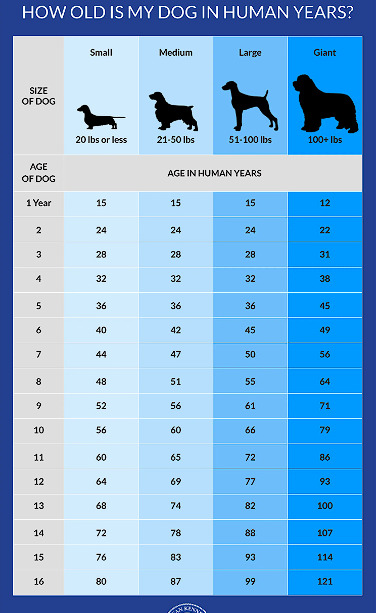
Canine gerontology is a growing area of study because dog owners want to increase the quantity and quality of their time spent with their pets. In order to "delay aging and promote healthy longevity," the Dog Aging Project is researching the aging process in dogs.
Every stage of our dogs' development, whether defined in human or dog years, is beautiful and endearing. Senior dogs are particularly endearing and poignant with their gray muzzles and thoughtful expressions.
2019 Epigenetic Clock Study
A new technique for estimating dog age was proposed in a 2019 study by researchers at the University of California, San Diego, based on alterations made to human and canine DNA over time. As DNA molecules age in both species, methyl groups are added, changing DNA function without changing the DNA itself. As a consequence, scientists have employed DNA methylation as a "epigenetic clock" to study human aging.
To compare the epigenetic clocks of dogs and humans, the research team conducted targeted DNA sequencing on 104 Labrador Retrievers with an age range of 16 years. The findings enabled them to derive a formula for converting dog ages to "human years," which they then used to calculate human age: human_age = 16ln(dog_age) + 31. You can use this natural logarithm tool.
Since only one breed was used in the research, the "human age" calculated for your dog using this formula might not be exactly accurate. Given that various breeds age differently, it's possible that the UCSD formula doesn't have enough variables to produce definitive results. Regardless, the newly proposed formula, which is supported by science, is unquestionably more helpful for determining a dog's "human age" than the long-debunked "multiply by 7" fallacy.
>>Make Your Dog Happy Click Here<<
#Don't capitalize canine breed names all the time. Many breed names are made up of capitalized proper words and lowercased generic terms (lik#Breed names frequently include a place name#as seen in the following references to the nation of origin of the breed:#French bulldog#German shepherd#Irish setter#Portuguese water dog#Sometimes the place-name refers to a region within a country:#Airedale terrier#Akita#Brittany spaniel#Labrador retriever#A generic term of foreign origin might also be combined with a place-name:#Lhasa apso#Another formulation for breed names includes the name of the person who created the breed:#Doberman pinscher#Gordon setter#Jack Russell terrier#Many breed names are composed entirely of generic terms#even though the terms may no longer be common parlance or may be of foreign origin:#affenpinscher#cocker spaniel#miniature schnauzer#Yet other breed names are capitalized according to convention and for clarity:#Old English sheepdog#Shiba Inu#These same guidelines apply to other animal breeds#like cats or cattle:#Maine coon#Texas longhorn
0 notes
Text
Belgian Malinois Dog Puppy Height, Weight, Price, And Special Info
Smart, confident, and versatile, the Belgian Malinois is a world-class worker who forms an unbreakable bond with his human partner. To deny goods the activity and enjoyment of your company are to deprive it of its reasons for being. The Belgian Malinois is squarely built, and proud and stands 22 to 26 inches.
Strong and well-muscled, but more elegant than massive, they have an honest, no-frills look about them, like beefy dogs built to work hard for their food. The hallmark of a race is the proud carriage of the head. Coat colors range from rich almond to mahogany.
Black ears and a mask emphasize bright, questioning eyes the color of dark Belgian chocolate. If you’ve ever seen a Maal perform an obedience routine, you know firsthand what a smart and curious breed this is. However, problems arise when this people-oriented dog is unemployed and neglected. Exercise, and plenty of it, preferably with their beloved owner, is the key to happiness.
Belgian Malinois Size Chart
HEIGHT: 22 to 24 inches (female), 24 to 26 inches (male)WEIGHT: 40 to 60 pounds (female), 60 to 80 pounds (male)GROUP: HerdingORIGIN: BelgiumCOAT: Short, smooth double coatCOAT COLOR: Fawn, mahogany, red, red sable, or fawn sable with a black maskLIFE SPAN: 14 to 16 yearsTEMPERAMENT: Intelligent, active, loyalHYPOALLERGENIC: No
History
The Belgian Malinois is one of four breeds of Belgian sheepdogs, developed in Belgium in the late 1800s. The four varieties are the Malinois (fawn-mahogany, short coat with black mask), Tervuren (fawn-mahogany, long coat with black mask), Lacanois (fawn, rough coat), and Gronendale (black, long coat). The American Kennel Club (AKC) recognizes all but the Lacanois as separate breeds in the US, while the United Kennel Club recognizes all four types as one.
formed
The Club du Chien de Berger Belge (Belgian Shepherd Dog Club) was formed in September 1891 to determine which of the various dog breeds were representative of the shepherd dogs developed exclusively in Belgium. In November of that year, breeders and fanciers met outside Brussels to examine the sheepdogs of the area.
After much deliberation, veterinary professor Adolphe Reul and a panel of judges concluded that the original sheepdogs of that province were square, medium-sized dogs with triangular ears and very dark brown eyes, differing only in conformation, color, and color. Hair length. Subsequent examinations of dogs in other Belgian provinces resulted in similar findings.
Recognition of varieties
In 1892, Professor Reul wrote the first Belgian Shepherd Dog Standard, which recognized three varieties: long-coated dogs, short-coated dogs, and rough-coated dogs. The Club du Chien de Berger Belge asked the Société Royale Saint-Hubert (Belgium’s equivalent of the AKC) for breed status,
But he was rejected. However, by 1901, the Belgian Shepherd Dog was finally recognized as a breed.
Today’s Malinois can be traced back to a breeding pair owned by a shepherd from Laeken named Adrian Jensens. In 1885, he bought a pale, shaggy-haired dog named Vos I or Vos de Laken from a cattle dealer in northern Belgium. The Janssens used Vos I (meaning fox in Flemish) to herd their flocks and also bred a short-haired, brindle-brown dog named Lise.
After that mating, Voss I was bred to his daughters, establishing a line of very homogeneous dogs with gray rough-haired and short-haired, and rough-haired and short-haired. Today, Vos I and Lise de Laeken are recognized as the ancestors of not only the modern Belgian Shepherd Dogs but also the Bouvier des Flandres and Dutch Shepherd Dogs.
Breeders decided to give each of the different varieties of Belgian Shepherd Dogs their own names. In 1898 a club was formed in the city of Malines to promote the Shorthair Belgian Shepherd dog. Louis Hügebert, an early breeder under the “Ter Heide” kennel name, as well as judge, author, and “Godfather of the Malinois” (and Bouvier), did much to help popularize this shorthair with the Malinois Club, hence the name “Malinois”. was associated with short hair.
Malins Club
In 1897, a year before the Malins Club was formed, Hugebaert suggested that since there were not many sheep left in Belgium, shepherd dogs should be given field trials showing their intelligence, obedience, and loyalty. From this recommendation, a dressage trial was developed for shepherd dogs that tested the dog’s ability to jump and perform other exercises.
The first dressage trial was held on July 12, 1903, in Malinis, M. Won by van Opdebeek and her Malinois, Cora van Optewel.
Belgian Shepherds were also used as guard dogs and draft dogs. They were the first dogs used by the Belgian police. Before World War II, international police dog trials became very popular in Europe, and Belgian dogs won a number of prizes in trials.
When World War I broke out, many Belgian Shepherd Dogs were used by the army for a number of jobs, including messenger dogs, Red Cross dogs, ambulance cart dogs, and, according to some, light machine-gun cart dogs.
Malinois kennels
During the 1920s and 1930s, several excellent Malinois kennels were started in Belgium. During the first decades of the 20th century, the most popular breeds of Belgian shepherd dogs exported to other countries were the Malinois and the Groningen. At the time, many were exported to the Netherlands, France, Switzerland, Canada, the United States, Argentina, and Brazil.
In 1911, two Groenendaels and two Malinois were registered as “German Sheepdogs” by the AKC. In 1913, the AKC changed the name to “Belgian Sheepdogs”. The first dogs were imported by the Joss Hansons of Norwalk, Connecticut. He sold two Malinois to L.I. De Winter of Gutenberg, New Jersey. De Winter produced several litters of Malinois under his Winter view Kennel name.
After World War I, many American soldiers brought back Malinois and other Belgian shepherd dogs from Europe, and AKC registrations grew rapidly. The first Belgian Sheepdog Club of America was formed in 1924 and became a member club of the AKC shortly thereafter. In 1924 and 1925, Walter Mucklow, a lawyer in Jacksonville, Florida, popularized the Malinois.
Breed Characteristics
Adaptability: 5 PointsDog Friendly: 2 PointsEnergy Level: 5 PointsTrainability: 5 PointsExercise Needs: 5 PointsAffectionate: 4 PointsGrooming: 1 PointTerritorial: 5 PointsWatchdog Instincts: 5 PointsApartment Friendly: 2 PointsBarking Tendencies: 5 PointsCat Friendly: 2 PointsChild Friendly: 3 PointsHealth Issues: 3 PointsIntelligence: 5 PointsShedding Level: 4 PointsSocial Needs: 4 PointsStranger Friendly: 2 Points
Appearance
The Belgian Malinois is a large herding dog. Bred to work, Malas are packed with powerful muscles, yet have an elegant appearance to their bodies. They are tall – up to 2 feet at the shoulder! — and always warns with quivering ears; kind, dark chocolate eyes; And a little bushy tail. The mullet has a thick, short coat ranging from mahogany to shades of mahogany, and it usually features a black mask and ears.
At a glance, Mal is often mistaken for a German Shepherd. Although they look similar – and both are beloved by police and military around the world – these dogs are unrelated, unique breeds.
Belgian Malinois weigh between 40-80 pounds, and males are usually larger than average-sized female dogs.
The Malinois’ waterproof coat is easy to maintain. Weekly brushing will get rid of its dead hair coat and distribute healthy oils, leaving your mane looking shiny. This breed sheds its coat twice a year, and you’ll want to continue brushing at least once a day during this period, or risk covering your home with dog hair.

0 notes
Text
How to Calculate Your Dog’s Age
New Post has been published on https://www.petculiars.com/how-to-calculate-your-dogs-age/
How to Calculate Your Dog’s Age
From the general development of their body to more in-detail changes like the formation of their teeth, there are actually a lot of ways in which you can identify a pet dog’s approximate age and then translate it into dog years. This is when, of course, you don’t have an exact birth date for the animal.
You’ve probably heard a lot of people saying that one year in ‘human years’ is around seven in ‘dog years’, but is this really the case? It turns out that things aren’t always as straightforward as multiplying its age with 7. Some new studies have uncovered that things will be a little more complicated than that and I`ll go over this in the next part of the article.
So how will you calculate your dog’s age?
So let’s go over the latest technique that offers accurate results in dog age calculation. Knowing how you will have to apply this step by step will make it possible for you to tell the exact stage in the life of a dog. Knowing the age stage of a dog’s life might help you figure out the best food, training, and activities for your dog, as well as its general needs. It’s also pretty fascinating and a great discussion topic at parties.
You might also like my articles on the best time to feed your dog, the number of nipples on a dog, and treating seed ticks on dogs.
Is 1 dog year 7 human years?
So let’s get back to basics: How real is the saying that one human year will mean 7 years in the life of a dog? Although this is a really popular saying, things are considerably more complicated than that. The human-to-dog age conversion will, in fact, change almost year to year and will depend on the size and age of your pet. The American Kennel Club explains it perfectly. According to them, pups will get around 15 human years in their first year of life and the second one will only equal to nine additional years.
When the pup will get past the two-year mark, these numbers will differ quite a lot. For larger breeds, the aging process will be faster per se, which means that they will have a higher human age equivalent than in the case of smaller dogs of the same real age. Before getting sad about the fact that your big dog might live less, keep in mind that this age estimate is just a number and there’s no correlation between it and the health of a pet or its life expectancy.
How should I calculate dog years to human years?
Although I’m sure you’re eager to find the quick match behind getting your pup’s age in human years, you will have to first go through a few steps before reaching this answer. This is easily broken down by the AVMA (American Veterinary Medical Association) below:
The first year of a dog’s life will be equal to the first 15 years for a human.
The second year of life for a dog will then be equal to about nine years of a human, which makes a two-year-old pup of medium size experience the development of a 24-year-old human.
From that point on, every year lived by a dog will be the equivalent of around five years lived by a human.
It might seem a lot harder to calculate the dog’s age as it gets older, but you should also consider another important factor. These statistics were made by the AVMA around dogs of medium sizes. When it comes to smaller breeds, they will usually age at a slower rate in terms of their human age. On the other hand, for larger dogs, unfortunately, their physical aging will be faster, which is quite expected and normal, so they will also have a shorter lifespan. This means that for larger dogs, one canine year will mean more than five human years.
The age in human years for a 10-year-old dog
As I already said, before getting into any calculations, we need to have an idea of the actual breed or, if this is uncertain, at least its size, to better estimate its human years. If you don’t have this information, then the age calculation won’t really work, because it will differ quite a lot between small pets and large ones. All websites presenting age estimations will usually refer to medium-sized dogs unless stated differently. A, infographic by the AVMA perfectly lists the human ages for dogs of 10 years of age as being somewhere between 56 and 78, depending on their size and weight. This estimation is similar to what the veterinarians from PetsWebMD got for 10-year-old dogs: 60 to 66 years for the medium to large dogs and 56 human years for smaller breeds.
Ask your vet for help
You can figure out the age on your own, but why get caught up between all the numbers? It’s actually not a big deal to ask a professional for help. Your vet will be able to estimate the pet’s human age within a normal consultation. An experienced vet will not only tell you the dog’s age but also offer you some pointers and tricks around reading the age of your dog.
In the end, this number doesn’t really matter and the happiness and healthy life of your pet should be the only thing to have in mind. It’s true that based on their human age, dogs will have different mental development stages, but these changes aren’t as obvious as in the case of humans, and you will also be able to figure out their mental stage through their activity levels and behavior.
0 notes
Text
Puppy Weight Calculator | Gram Your Pup — Dog Weight Calculator

Sex also can play a crucial role in determining puppy weight. Male dogs are often bigger and heavier than female canines of an equivalent breed. If you have a male puppy, your pup will presumably be larger than his mother if the daddy is of a comparable breed. If the daddy wasn’t much bigger, a female puppy could finish up being an equivalent size as her mother.
How much your puppy weighs as an adult will be influenced by his nutrition and activities. Dogs, like us, may gain weight. Obesity has significant health implications for dogs, even for humans. But with our Dog weight calculator, you can easily maintain the grams of the dog.
While neutering won’t improve your puppy’s total weight, it’ll make him more susceptible to becoming overweight if you do not adjust his diet. Because your puppy’s energy demands are reduced due to the drop in sex hormones, you’ll get to feed him less frequently. Remember to consult your local veterinarian before altering his food; bear in mind that if you neuter him before he’s a year old, he’s still developing and requires more calories than an adult dog of equivalent size.
How Weight Depends on Different Dog Breeds?
The time it takes for your puppy to achieve mature weight is decided on his overall size. Toy and tiny breeds will grow faster than massive breeds generally. Toy breeds can do adult weight as early as eight months, whereas the most important big breeds will grow until they’re two or three years old. Small, medium and giant breeds will all fall under an equivalent category. With Monkoodog’s Puppy Weight Calculator you can keep a good look at your pooch’s weight according to his breed and look out for abnormalities.

Dog breeds are divided into five groups based on their size, but it should be kept in mind that sizes may overlap due to the mixing of breeds.
Toy
Small
Medium
Large
Giant
Get a mathematical estimate of how large your puppy will grow in a moment with monkoodog, supporting your puppy’s present age, weight, and breed; our puppy weight calculator forecasts his adult weight. Then, on an interactive graphic, you’ll watch his growth curve.
#Puppy Weight Calculator#Dog Weight Calculator#Dog Size Calculator#Puppy Size Calculator#American Bully Weight Calculator#Pomeranian Weight Calculator#Staffy Weight Calculator#Puppy Growth Calculator#Puppy Weight Predictor
0 notes
Text
Essential Facts About dog lifespan

Dog ownership is life's greatest pleasure. Your animal pets provide you with unconditional love, companionship, and smiles. However, there are disadvantages involved with dog ownership. You can put up with messes and other minor irritations; it is the unavoidable fact that humans live longer than dogs that finally takes most owners to tears. When owners consider the ultimate loss of a cherished pet, they frequently wonder about the dog's lifespan; There is no way to answer that question directly for a given individual, but averages for a variety of well-known breeds are available.
Aging in dogs is breed-specific and affects the dog's health and physical ability. As with humans, senior years frequently result in alterations in a dog's capacity to hear, see, and move freely. With old age, skin condition, appetite, and energy levels frequently decline, and medical disorders such as cancer, kidney failure, arthritis, dementia, and joint infections, as well as other indicators of aging, may manifest.
Combinations of breeds. Owners of mixed-breed dogs can use an individual's weight to estimate dog lifespan. Small canines, on average, live longer than their larger counterparts. A recent review of veterinary records indicated that puppies weighing less than 20 pounds survived an average of 11 years, while those weighing more than 90 pounds lived only eight years. At approximately 11 years of age, medium and giant canines fell in the center. However, average life expectancy does not tell the entire story. The term "average" implies that many individuals will live shorter lives than the norm, while others can expect to live significantly longer. Perhaps a more accurate way to determine the longevity of a dog is to convert canine years to human years. Thus, we can decide if a dog is an adult, a senior citizen, a geriatric, or a human counterpart.
Aging profile. According to common belief, one canine year is equivalent to seven human years. On two counts, it is deemed inaccurate: the first year or two years represent around 18–25 years, and the ratio changes according to size and breed. One size fits all — Another widely used system for dog lifespan proposes that the first two years are equivalent to 10.5 human years each, with the following years equal to four human years. It is correct but does not account for the crucial effect of size/breed. Calculators for specific sizes or breeds attempt to account for the animal's size or breed. These are the most precise classifications. They often work based on the dog's predicted adult weight or classify it as tiny, medium, or giant.
Aging effects. By and large, dogs mature similarly to humans. Their bodies start to develop problems that are uncommon at younger ages. They become more susceptible to severe or fatal conditions such as cancer, stroke, and others; they become less mobile and experience joint problems such as arthritis. They frequently become less physically active and may even develop dementia. Besides, they lose their ability to cope with change, especially significant climatic or temperature variation, and may suffer nutritional or skin problems or become deaf. In some instances, incontinence and respiratory issues may emerge. Aging occurs at birth but does not exhibit itself for several years. The first indicator of aging is a general decline in activity level, including a desire to sleep longer and more soundly, a loss of excitement for long walks and games of catch, and a lack of interest in domestic activities.
Diet. There are some differences of opinion regarding the optimal diet to improve dog lifespan. Senior dogs are frequently fed professionally prepared senior dog food diets. At least two dogs, however, were documented as having died at 27 years old after being fed non-traditional diets: a Border Collie fed a completely vegetarian diet, and a bull terrier cross provided kangaroo and emu meat predominantly. They passed away only two years and five months after the oldest dog ever reported, Bluey.
Neutering. Neutered females lived the longest of all dogs that died, whereas whole females lived the longest of all dogs that died naturally, with neutered males having the shortest dog lifespan in each category—at the same time, fixing decreases or eliminates the risk of specific causes of early death. As well as indirect causes of premature death such as accidents and euthanasia, intact dogs roam and are more aggressive, and neutering males may increase the risk of death from other reasons. Neutered males may have a higher rate of urinary tract cancers such as transitional cell carcinoma and prostatic adenocarcinoma. When evaluating the findings of these investigations, caution should be exercised.
1 note
·
View note
Text
To start off, Myria is a medium-sized country north of Melamarc. Contrasting the sunny towns and forests of Melamarc, the environment of Myria is very hostile, that's excluding temperatures below freezing. The people, however, are warm and content due to them placing importance on not only surviving but living and thriving as well.
Environment
There are many mountain ranges tipped with snow and that have hidden caves. Myria is known for its many deposits in ores, specifically magical gems with very powerful elements in them.
The country is not only known for its violent climate or rare materials but powerful monsters, particularly deep in the caves, are undead. How curious. The monsters are also powerful outside of the caves and even the type of monsters that would be around Melamarc's capital are strong. What makes most of these creatures dangerous is also that they've evolved to blend in with their environment to be able to ambush prey and to camouflage themselves to not be prey.
It's a dog eat dog world especially for these foul beasts.
Culture and Relations ect.
Community and family is at the core of Myria culture, there are even myths involving such ideals. Their state religion has this as its core teaching and is called "Faith of the Fox". No one actually knows how it came to be. Some people of old say the fox is a depiction of a hero but with how each hero is depicted in any other religion it seems impossible. But the raven character, which to people of our world would be their equivalent of the "devil".
Speaking of which, the country surprisingly uses corvids, specifically magpie-like birds for sending messages in a fast and neat manner. But most people in the present day (other than the queen) use magpie messagers due to the negative correlations that any corvid has.
Foxes are sacred and not to be harmed but of course in certain circumstances such as them harming you, you would be able to. This also applies to corvids but for the reason that you might get cursed or something of the sort.
We'll get to how corvids, specifically ravens, got demonized at a later point.
Since Melamarc is so close they were bound to have some relations and they are on good terms! In fact they trade materials like magic iron and magical gems for vegetation not able to be grown in Myria's climate (and other resources and services)
On a different note the weather and monsters aren't the only differences from Melamarc. The power is shared equally with the king and queen and inherited by their child no matter their gender and based on their skills as a leader.
They also pray to many different gods and goddesses other than the fox (god of harvest, light, fire) and Raven (god of death, rot, water/ice, and darkness). If I'd have to compare it to a religion in reality I'd probably say something between Norse mythology and wiccan.
History
Surprisingly it's pretty ancient and it's people have a bit of a history of being violent towards outsiders (mostly bc they were to them but to each their own). Although now in recent times open and welcoming to outsiders esp Melamarc.
Theres a lot to unpack but remember when I said I'll talk abt the actual reason for the faith of the fox and raven is because of a large scale event that caused many to suffer.
Long ago, even before the heroes during Fitoria's time, the five heroes were summoned to do their duties. Each were summoned in five countries, Myria being the country the axe hero was summoned. He wore other world clothes like a jacket and jeans but was similar to their world's demi humans with fox ears and a tail.
He trained and met the four others, it was said that he grew closer to the shield hero of that time.
They fought the waves as intended and defeated foes that weren't beasts but still monsters in their own right.
One such monster was what inspired the character "the raven".
You see raven and any corvid demi humans all have dark affinities but the raven and crows are a special case. Unlike most of the sub species power being just seeing and even being able to talk to the dead the crows and ravens can raise the dead.
He joins the axe hero's party due to him being a fellow demi human, they go on their journey some more and the raven tells the fox about a town need saving from banshees.
The party goes to the town in Myria and finds a gruesome sight of blood and dismembered limbs.
No one knows the raven's motivations for his betrayal but some say he was possessed by a demon since corvid demi humans are susceptible to those things but some say it was just for power.
But ultimately he was defeated and sealed away…in the hero's axe since at the time there was no other way to seal or kill him at the time (he was alone)
He walks away, traumatized and with an empty cold feeling.
This wasn't a victory, it was just a slaughter that he survived. And all the evidence of what just happened were just his fatal wounds and the dark magic that seeped into the earth.
He lives on and journeys on his lonesome saying it to best, the shield hero disagrees. Not just as a fellow hero, but as a worried friend. Still the fox goes on his own.
He finds that his once green eyes became icy blue, and his soft human hands became tinted with black scaly marks and talons. Familiar feathers start poking up from his skin, he was changing. And he knew this had to do with something about the seal within the axe but what was he to do? Unleash an evil such as the raven, or sit in solitude fighting for control.
He chose the second option, which was fatal.
He lost that fight and the raven came back.
The four heroes found out the things that the axe hero has done and when they went to check it out, they didn't even recognize him at this point. His arms became part of wings and he had two sets upon his back, his joints weren't human but weren't monster either. But he definitely wasn't a demi human at this point.
He put up a fight but with the bow and sword hero stopping the shield hero from intervening, was slain by the spear hero.
They were shaken to say the least and told everyone that he wasn't himself and should be remembered as a hero for trying to kill such an evil beast such as the raven.
(I'm so sorry if this is choppy or anything bc my brain is not working but I wanna get this down)
Ok whoo hoo let's get to the monsters, fighting, magic!
Remember when I said that the necromancer's magic seeped into the earth and that theres alot of undead creatures around Myria weeeellll…yeah they're connected.
This is also based on alot of Scottish mythology as well like the fae and stuff like that.
There's banshees, skeletons, zombies (of all kinds be it humans and monsters), headless armored soldiers, just alot of undead so you usually don't see people out at night and theres lots of myths abt monsters taking kids that wander into the woods which are uh ah ha actually true.
Terrifying, right?
The people are taught at a young age how to either fight or heal by their families (be it fighting/healing with traditional means or magic). How patrols work is a buddy system with one being a soldier and another person wielding holy power.
Most magic that's used is water and fire, also bc if someone is powerful enough in water magic then they might be able to control snow and ice (fire is self explanatory.)
Ok ok I'm losing brain cells I'm done with my info dump ask any questions if ya have any abt this made up country lol
----------------------------------------
@shieldherostuffs @localwitchash
#rotsh#tate no yuusha no nariagari#rising of the shield hero#rising of the shield hero oc#oc stuff#Elijah Renard#give me your opinions pls pls I need em🤲#not me making up my own lore oop-#also do ya think like the heroes of the past gone thru the same shit but were more closer to eachother and didn't constantly fight#id say that how each of my ver of the past heroes acted were like the archetypes of the five man band and the axe hero was the heart of the#Group and kept them from coming at eachothers throats lol
6 notes
·
View notes
Note
Prompt you say? SGA: "Kick at the darkness till it bleeds daylight", perhaps?
Ohhh, Lovers in a Dangerous Time lyrics!! :D I've used that exact quote before as a fic title, so my immediate association is now sappy h50 ace fic, haha.
But it is a VERY GOOD line that definitely works for sga, thank you, anon! Hope it's okay that I didn't include it literally but kind of... took it and ran. Very far. In a direction that maybe wasn’t on the map.
---
It’s a black box. Not a black box like a black box is a black box, like the flight recorders on planes that are actually bright orange and that John would know what to do with (i.e. hand it over to Rodney and wait), but a black box in the sense that it is a box, that is black, and that some genius took from one of the most remote wings of Atlantis and that has now attached itself to the floor in a corner of the science lab and is... pulsating. And perhaps also-
“Is it growing?” Teyla asks.
Rodney whips his head up so fast that John, who’s been watching the readings he’s taking over his shoulder (in the vain hope of it suddenly becoming A) something he can shoot at or B) a math problem), almost gets his nose bashed in. “I think it is.” Rodney does not sound as calm about this as Teyla did. “And I’m seeing a weird energy build-up.”
John weaves past him, unobtrusively putting himself between Rodney and the maybe-growing alien object. It’s currently about the size of a medium dog. He eyes the floor around it. “If we really need to get it out of here, can we-”
“Yeah,” Rodney says, hesitantly reading John’s mind about taking a piece of the building with them if all else fails. “But I wouldn’t recommend blowing it up, so that’s going to take a lot of work.” He stomps his foot to needlessly illustrate the solidity of the building. “The ancients designed their stuff to last.”
“It looks like an Earth television box,” Ronon offers, apropos of nothing. He’s frowning. It occurs to John that this might be the first time Ronon has been in the labs, ever, but they needed him to make absolutely sure that no human being could move the box even an inch, and to in so doing confirm that this was a thing to potentially be very worried about.
“A tv isn’t smooth and black all over,” Rodney says. “Or this perfectly square.”
John shrugs. “It could be.” He says it not really because he thinks it's an useful point to make (this is not an Earth tv any more than it is an Earth flight recorder, because then Ronon would never have been called in), but for the disgruntled look Rodney throws his way because of it.
“Should we get a hammer and chisel?” Teyla asks, neatly pulling them back on topic by their conversational ears.
John’s arms feel sore at just the thought of chiselling through Atlantis. “A drill might be-”
Ronon steps forward and gives the box a good kick.
A hush falls over the four of them as they wait. There is an ominously loud creak, then a hiss that has Rodney blanching even as he keeps typing like mad, and suddenly there’s a thin, jagged crack visible. It’s a white line splitting the previously solid black, running right around a corner, and the vague pulsing has stopped but the box still seems more alive somehow than most regular objects. Whatever is inside is bright, bright like blinding, bright like forgetting your sunglasses on a cloudless day in snowy pure white Antarctica bright. Flashbang, John thinks with a spike of nerves, but as he’s still thinking it there’s movement. He doesn’t even have time to draw his gun - it’s just pop, and a bright little circle pops out of the crack in the black box.
It’s a little more yellowish than the light inside seemed, and far easier on the eyes. It floats, hovering in the air right above the box for a second or two before gently, lazily drifting higher, higher until it bumps into the ceiling of the science lab and bounces back a little and then just hangs there, impossible, suspended in the air, and-
“It’s a sun,” John says, finishing his own thought for once. And it is - a yellowish ball of light about the size of a tennis ball, but with blunt spikes of darker yellow light attached, exactly the way a kid would draw a sun with crayons, just minus the little happy face in the middle.
And then it’s pop and when John looks down he sees another, identical little sun has just escaped the box, and while he’s still looking it’s pop, pop, poppoppoppop-
It gets pretty noisy for a moment, but as all of the little suns drift up to join the first one near the ceiling, they make a very pretty sight. “The Festival of Lights,” Teyla says. She sounds awed, but also like she understands now, so John fully relaxes. “We celebrated it on Athos on the darkest day of every year. This is the most beautiful decoration I’ve ever seen.”
For every pop Rodney counters with at least five taps to his tablet, but now his fingers are slowing down. “It seems harmless,” he says, and he sounds almost dismayed. “Like very scientifically advanced fireworks, with less danger of losing a finger. How did you know?”
All eyes turn to Ronon. Ronon shrugs. “Sometimes you have to bang on the tv to make it work. Sheppard taught me that.”
“Well,” John says, as an excuse to release the breath that’s been caught in his throat. It’s gone silent. The previously lit crack in the box is dark now, and the box is just a weird broken black box, clearly having done what it was supposed to do. When he cautiously nudges it with his foot it moves with the ease of empty carton. “Yeah. Well done, buddy. You solved a science problem before McKay.”
“No!” Rodney protests, easily offended. “He very much did not.” He waves his tablet at the ceiling in a borderline threatening gesture, and a few of the suns bob in response, apparently sensitive to disturbances of the air. Light as a feather, as well as the sun. “What he solved is the Ancient equivalent of a piñata.”
John pats Rodney’s back. “Just be glad Ronon used the right definition of bang. This could have ended very differently.”
“What exactly did you teach him when we were on Earth?”
John rolls his eyes, elects not to answer that, and instead goes looking for a broom to see if he can make the horde of little suns bounce along the ceiling a little more to make Teyla smile.
#this is NOT ALL THAT SHORT#just did a wordcount and it's like. a full 1k OOPS#i'm working on the other prompts!! thank you all!! it's just going to take a little while if i keep abandoning the drabble idea#which as far as i'm concerned is a GOOD thing by the way!!! this was FUN and that was exactly what i was looking for 💖#sga#my fic#*#stargate atlantis
21 notes
·
View notes
Photo
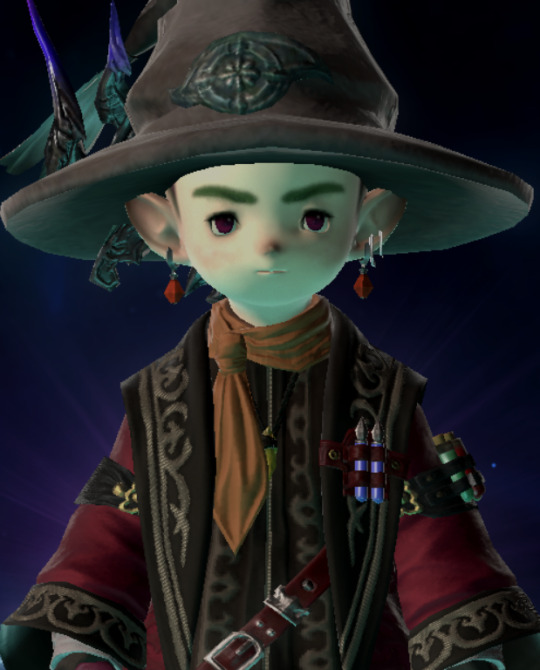
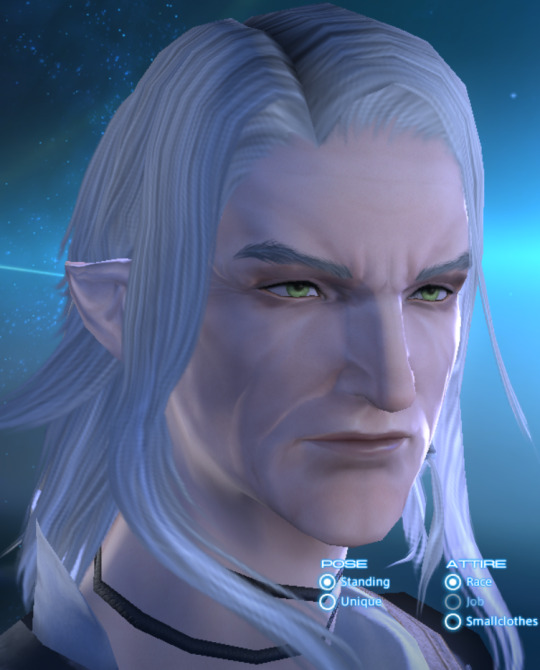
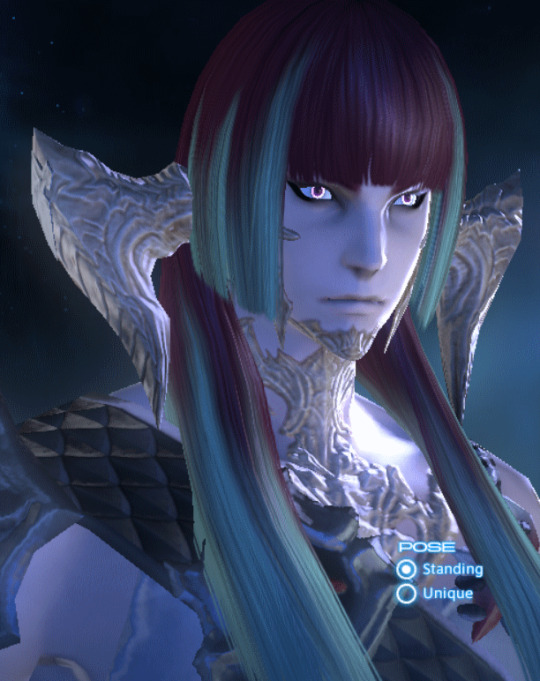

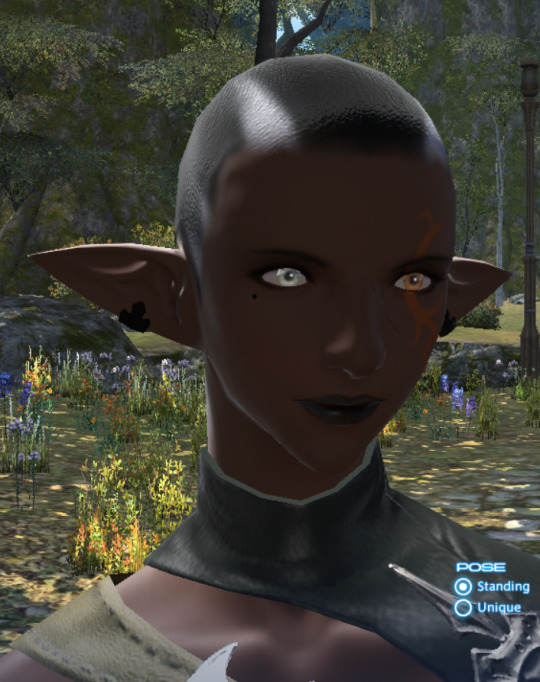
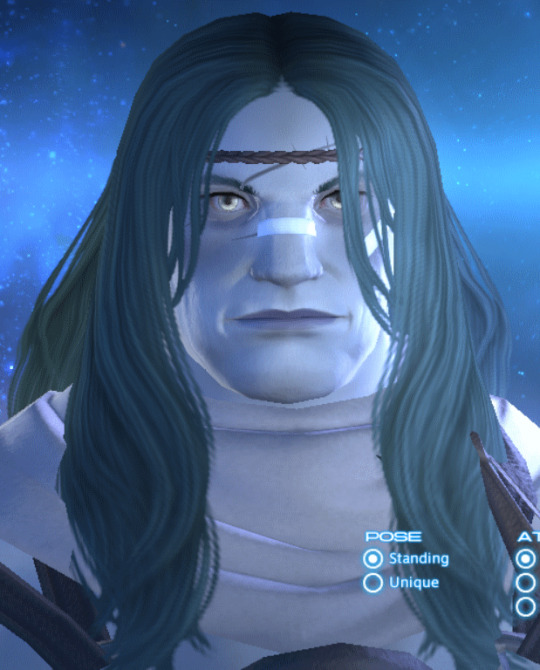
moving my oc stuff over here!
redoing some of what little descriptions I gave them (the world i made up for them is a mix of dragon quest & final fantasy so certain terms may or may not apply):
Broccoli Brassica (gnome):
about 25 in human years
had a near death experience during what would commonly be interpreted as an endgame quest (even though my world isn’t an isekai or anything) with a massive raid group
his staff was destroyed which severed the aetheric link to his life energy, but he was able to muster the will to live, transforming it into a crystal wand in a miraculous burst of power that helped weaken the boss, though it went unnoticed by the raid group
wants to be a warlock (equivalent of red mage/battle mage/armamentalist in this world)
is very much like a capable jeffrey lebowski
is under the tutelage of rutabaga
(more coming soon!)
Seiyuu: Junko Minagawa
Rutabaga Erfinen (faerie):
appears to be a human in his 70’s
a seemingly bumbling lancer/dragoon whose demeanor belies ancient wisdom & power; is actually a battle chef
was part of the same raid group as broccoli
has lived long enough to study many different schools of magic
his famously stalwart patience runs thin when confronted with societal lack of empathy for young ppl
is the fanservice character; he normally looks like a conservatively dressed old man with a walking stick but he wears a glamour prism-esque henshin crystal around his neck that allows him to transform into his lancer gear (latex ooh-la-la outfits & the like & he operates his lance like a stripper pole)
is completely unaware of the big crush broccoli has on him (which doesnt exceed past ogling & blushing but thats part of the fanservice since broccoli is the central character)
unfortunately doesn’t look very much like the screencap. i have ideas for him in my head but customization in ffxiv simply isnt good enough to capture it
(more coming soon!)
Seiyuu: Shuichi Ikeda
Radicchio Castelfranco (dragonborn):
about 28 in human years
was also part of the aforementioned raid group
rushed to Broccoli’s side when he collapsed & protected him until he recovered, forming a strong brotherly bond between the two
affectionately calls broccoli “big bro/aniki” despite being older as a form of admiration & respect
is a brutal martial artist who regularly partakes in tournaments to show off
is very vain & meticulous about his appearance, which contrasts with his brash & competitive personality
is the walter sobchak to broccoli’s lebowski
(more coming soon!)
Seiyuu: Tetsu Inada
Watercress Cardamine (seaborn):
about 35 in human years
also part of the raid group
is a gallant mariner who forsakes the pillaging & senseless violence characteristic to the class for adventure & heroism
is a stone butch bi with a preference for older men, & has somewhat of a don juan reputation
is also a skilled metalworker; is capable of making or reforging weapons and armor for the party
(more coming soon!)
Seiyuu: Mitsuki Saiga
Chia Figue (vampire):
about 29 in human years, but has lived about as long as rutabaga
is a beastmaster whose contract is with a large chimera named pickle; also minored in magecraft and crafting (woodworking, leatherworking, metalworking) in order to make care items for her chimera and easily store them through magical means
as a cub, pickle's goat head never grew in properly, causing it great pain. chia worked with her instructors to genetically modify pickle so that its goat head and lion head became one. pickle grew up healthy from then on, and has been with chia for most of her life. its modified genes allow it to change its size at will from that of a medium-sized dog to that of a house. chia is exceptionally skilled at phasing into pickle's body to see through its eyes for remote battle, the catch being that she can only see through one head at a time.
is often mistaken for a mage, since she dresses in a gothic/witchy fashion
is fascinated with the unconventional; she loves all sorts of bizarre, grotesque, and uncanny things that occur in nature, like bugs, strange plants, and fungus; she also loves hardware and tools and tries to catalogue/collect them much like others would with cool weapons/armor
(more coming soon!)
Seiyuu: Masumi Asano
Asario Cardamine (seaborn):
about 30 in human years
abandoned by their parents at 7 & 14, asario and watercress had to fend for themselves, which led to their individual fields of study; asario wished to be a traveling doctor, while watercress wished for an adventure-filled life free of fiscal instability
(more coming soon!)
Seiyuu: Yoshimasa Hosoya
17 notes
·
View notes
Text
Gullon

“Wolverine” © Ryan Wardlow, accessed at his deviantArt gallery here
[This monster appears in Monstrosities as the “draug”, which is a name I dislike for multiple reasons. First, it’s just the word “guard” spelled backwards. Second, draug are real monsters! They’re Scandinavian undead, not furries. The original says that they are “bear like humanoids with the head and tail of a dog”, so I figured that wolverine was a suitable animal intermediate in physiology. Plus, anthro wolverines are rare (and much camouflaged online by the X-men character). Besides those conceptual changes, this is very similar to the original, both in mechanics and flavor. It’s a big anthro Viking. What’s not to love?]
Gullon
CR 3 LN Monstrous Humanoid
This broad, tall humanoid has the head and tail of a wolverine. They are clad in armor and carry weapons and a shield.
Gullons are oversized mustelid-like humanoids with a lust for life and a skill for violence. Most of them make a living as traders, raiders, mercenaries or bodyguards. A gullon stands about eight feet tall on average, and they tend towards broad and stocky builds. Their lifespan is equivalent to that of humans. Males and females are almost impossible for outsiders to tell apart unless pregnant or nursing.
Most gullons are enthusiastic combatants. They typically start out in formation, setting up in a strategic way before breaking off to fight. A gullon in need of help will unleash a stirring battlecry, and gullon companies will alternate rallying howls in order to maintain the morale effect. Although they will flank and otherwise coordinate for tactical advantages, they are very proud of their individual prowess, and typically keep score of kills and other achievements. A gullon will fight to the death when its blood is up, continuing the melee even as it bleeds out.
Gullons fight hard and play hard. The center of gullon social life is the mead-hall, decorated with trophies of their victories and the weapons and shields of the fallen. Gullons have a taste for finely crafted weapons and armor, as well as silver jewelry. The society of gullons is held together with layers of intricate, multi-generational debts and obligations. They tend to throw themselves into their work with zeal, and even those that have distaste for combat take pride in their crafts. They view math as a kind of magic, and hold accountants and bookkeepers in high esteem.
Gullon CR 3
XP 800
LN Large monstrous humanoid
Init +4; Senses darkvision 60 ft., low-light vision, Perception +8, scent
Defense
AC 18, touch 10, flat-footed 19 (-1 size, +1 natural, +6 armor, +2 shield)
hp 25 (3d10+9)
Fort +4, Ref +4, Will +4
Resist cold 5
Defensive Abilities ferocity
Offense
Speed 30 ft. (40 ft. unarmored)
Melee battleaxe +5 (2d3+2/x3), bite +0 (1d6+1) or bite +5 (1d6+4)
Ranged longbow +2 (2d6/x3)
Special Attacks battlecry
Statistics
Str 17, Dex 10, Con 16, Int 10, Wis 11, Cha 15
Base Atk +3; CMB +7; CMD 17
Feats Alertness, Improved Initiative
Skills Climb +6, Perception +8, Sense Motive +5, Swim +2; Racial Modifiers +4 Climb
Languages Common, Giant
SQ martial proficiency
Ecology
Environment cold forests
Organization solitary, band (2-5), company (6-10 plus 1 lieutenant of 2nd level) or squad (18-30 plus 1 lieutenant of 2nd level per 6 individuals and 1 6th level captain)
Treasure standard (masterwork chain mail, heavy wooden shield, battleaxe, longbow with 20 arrows, other treasure)
Special Abilities
Battlecry (Ex) A gullon can howl as a standard action, inspiring all its allies within 100 feet. The gullon and its allies gain a +1 morale bonus to attack rolls, saving throws and skill checks for a number of rounds equal to its Charisma modifier. A gullon can use this ability once per day.
Martial Proficiency (Ex) A gullon is proficient with all simple and martial weapons, light and medium armor, and shields.
34 notes
·
View notes
Text
Humans are Space Orcs, “Tanana.”
This was super fun to write this morning. A little bit funny, and I always enjoy hurting Adam a little, accept in a fun way this time no angst.
Hope you guys like it :)
Just a little bit closer.
The small creature looks on innocently munching on a crop of moss. It has four large eyes, two on either side of it’s head, six legs and is about the size of a small to medium-sized dog. It has really long ears, and if it stays still long enough, it’s going to be my dinner.
I scoot closer over the rock arm raised to the low ready, the spear clutched tight in my right hand.
The creature lifts its head.
Shit, it must have heard me. In my panic, I make a decision out of haste and throw the spear. It goes wild and clatters across the stone. The Drev rabbit takes off, and I am left standing stupidly in the middle of the open field weaponless and looking like a jackass.
“Tsa din dasdarish darat?”
I nearly leap out of my skin, turning around to find Hijan standing a few meters behind me near a coiltree.
“Shit, hijan, do you really have to sneak up on me like that.”
The old drev looks at me in amusement. I Know she doesn't understand most of what I am saying, but somehow I think she still gets it.
“Zha deengan.” I say, one of the first phrases I learned how to use. Being able to say I’m hungry is very important in any foreign language.
She tilts her old wizened head at me, “tsa tin danehanish ee dengish?” You were going to kill and eat that?
I shrugged, “Yid zha deengan.”
She crosses her arms, a habit she’s picked up from me, “ene tsa deengan datadish zha dadee sa deeng datahaik.” IF you were hungry I would have given you food.
I sigh, she wouldn’t get it, but still she walks over and hands me a miss twist. I call them that because of their distinct shape, kind of purple and in a strange sort of spiral. When you dry them out they are crunchy like chips though not particularly salty.
I munch absently on the weird plant? Fungus? And she absently plays with my hair. I try to shrug her off, but she’s a lot like my mother in the way that she won't let me be. I am about 100% sure she thinks I am one of her Drevlings. Which has caused a bunch of interesting changes in my life as of recently, not one of which was her decision that I wasn’t colorful enough.
Apparently Drev see humans a lot differently than we do. They can see the way the UV light interacts with our skin. She describes thousands of little spots which turn into swirling stripes. When I asked her to describe the color she said it was similar to turquoise or blue, though I obviously can’t imagine it.
Makes me jealous as hell though.
However, she said my “Carapace” wasn’t colorful enough. When I asked her what she was on about she clearly meant my hair and my nails, which are made up of similar stuff to the Drev carapace.
Long story short, I now have green hair and nails.
Yeah yeah, laugh all you want, but whatever the hell she put in my hair is not coming out. And when I say green, I am not talking like a nice moss green or forest green. I am talking like the color you paint your new Lamborghini kind of electric green.
Not to say that I haven't had my nails painted before, but never this color, and never in tandem with bright flaming green hair. Don’t know why everyone associates me with the color green. I would say it was only my second or third favorite color. Either way, I look super weird as of late, green hair green nails, no shirt, no shoes, and a slowly expanding five-o-clock shadow.
You know I am not a big fan of beards, mostly not a big fan of them on me, but I forgot to bring a razor, so in that department I am kind of fucked.
I mildly wonder if she is going to make me dye my beard green when it finally grows in.
She makes me grab my spear, grabs me by the hand and drags me back towards the village. She doesn’t let go of my hand. I don’t try to fight her, she is stupidly strong, and despite being a grown ass adult, I am apparently her child now.
The other drev find her adopting me very, very funny, but at least now that she has they don’t call me dazhit anymore. The last time someone called me a bitch in front of her, she kicked the crap out of them. I thought it was pretty funny personally. They danced around the circle like a loon expecting her to be weak in her old age, and she just stood there then jabbed them in the throat with the butt-end of her spear when they weren’t expecting it.
I laughed so hard I cried.
Ever since, they have treated me with a little more respect.
We make it to the village, and with one hand she pushes me off towards the training grounds as if to say, “Go join the other kids.”
I sigh and roll my eyes but go.
The last time I tried to skip out she almost had my hide.
I go at her bidding meeting up with the others who are around my height. Hijan watches sometimes, and she has made it very clear that the kids deserve to get the shit beaten out of them. I don’t like it much, but these kids don’t seem bothered when you knock them around. In fact, most of them like it.
I think our trainer is a bit mad that I can actually fight.
I smile to myself
Now that I do fight, I am at the top of the class.
The kids think I cheat, difference is I have different training than they do, and a lot more experience in combat despite what the Drev seem to think.
“Tanana! Naktan ts adon.” Tanana, my nickname, or my drev name I guess means alien. Hijan doesn’t like the name much, so she calls me tsata which means gift. Personally I am pretty flattered she thinks that about me.
I walk into the circle at our leader's orders and Dark ‘the other kid’ steps into the circle across from me. He’s an ugly little shit, and I’m not just saying that. He’s a dick to me on most occasions. When our teacher isn’t looking sometimes I make fun of his coloring, that usually shuts him up. I should probably feel bad for making fun of a kid, but I really don’t. He's a dick and everyone knows it.
Problem is now he has a bit of a vendetta against me, and is pretty hell-bent on putting his spear through my throat.
Good thing we only fight in hand-to-hand combat these days.
“Aleeshazh!”
The kid does not wait till the end of go before he is charging at me hands wide Some of these kids are under the impression that guarding your center is like…. Dishonorable or something. They would be wrong because even Drev now it’s stupid to come in arms wide open. However, at this point I’ll take what I can get.
I dodge past two sets of arms and come in sharply towards hims middle. He has reach on me, so I go in close and brutally aim for what I am hoping is his liver, if Drev have them. My single punch has him staggering back across the circle gasping.
The teacher does not look happy.
I feel kind of smug.
Of course the little brat won’t give up, I’ll give him that, he isn’t a quitter, and charges for me again.
He’s making this too easy,
I wouldn’t call myself a martial arts master or anything in the slightest, but before he knows what’s happening, he’s on the ground with my legs across his chest. I pin his lower arms with my right leg squeezing his upper arm between both. I have tight hold of his wrist, and just as he begins to squirm, I slowly place upward pressure on his elbow by arching my hips upward.
If I wanted to I could snap the joint.
Damn I love a good arm-bar.
He squirms and squeals for a couple of minutes as I continue to apply pressure until the teacher eventually tells me to knock it off.
I let go and he frowns at me. He doesn’t approve, but there isn’t uch he can do. My move wasn’t against the rules or anything.
He looks at me for a long moment eyes narrowing at my unconcealed expression of pride, and a hint of smugness.
I can see he wants to wipe the look off my face, “zha jasti tsa jej atatchan teeya dzhalakat.”
I grin, “Of course I am too skillful for children. Surprised it took you so long to see that.”
He does the drev equivalent of a frown. I know he can understand most of what I am saying, unlike others, but I think it still annoys him when I speak English.
Tough luck bro, my mouth goes way faster than my brain, its one of my worst qualities. If it didn’t I’d speak Drev More, but for now it was going to take practice.
“Ene tsa ditan atatchan juhkee tsa tehish zheengat s dzhal.”
Well shit.
His if you are so skillful than you can fight with the adults was not an encouraging statement.
I honestly hadn’t meant that to come out as dickish as it did, but now I was definitely already regretting my decision to be a smug bitch.
Guess that is what karma does to you.
I see Hijan at a distance, watching as I am dragged over to the next training field. The Drevlings follow at a distance chirping to themselves excited to see me get my ass beat.
We come up over the rise just as one of the training circle is in session.
Two Drev go at each other with spears so hard sparks are flying. Their feet cut tears in the moss as they push each other across the stone. As we come up one of them is hit in the head so hard they are knocked completely out of the circle.
“Dazhit.” I mutter
Our teacher and their teacher stop to speak at each other. I can see them staring at me pointing and speaking quietly with each other.
The older class adjusts themselves and looks on in great interest.
I don’t know these guys well, but I am pretty sure I am about to know the butt of their spears pretty well.
I sigh and shoulder my own spear, which…. Is significantly shorter than everyone else’s.
I’m not self-conscious.
“Tanana daeen hajish.”
I walk over as ordered my spear still over one shoulder.
“Tsak nantan tarik.” Your new teacher
I lower my head, “Tarik”
She seems amused and motions towards the circle, “Tanana ts adon. Zha nin tsa tehish darat zhegingi jastat.” get in the circle, I want to see what you can do.
Oh, great.
I do as told stepping into the circle as she calls one of her students forward. She’s a light colored Drev, the color of cream/orange rose petals. I am pretty sure the Drev would consider her pretty…. Did I mention that she’s at least two feet taller than me?
No
Well she is.
She rams her spear butt into the dirt, and I swallow hard.
The Tarik waves a hand and we begin to circle.
I hold my spear like they taught me, though I am much better at hand-to-hand combat. We test each other for a minute moving forward and back, watching each other’s guard. Of course, she strikes first though.
I dodge out of the way quickly, expecting to come in and wrap her across the back of the knees, but she spends around and blocks me at the last moment. We connect together so hard that my hands go almost immediately numb.
She brings the butt of her spear around, and I am just barely able to duck under it. She comes at me again, and I step back as the spearhead slices past my chest.
My eyes go wide as I stare at my almost evisceration.
I barely look up in time to block her fro the side.
The hit makes my bones hurt.
I flick my spear up trying to catch her in the face, but she knocks me away with impunity.
She has me backed against the edge of the circle.
She doesn’t expect me to make it out. Too bad I have seen way more action movies than she has. As she cuts over me, I slide under the cu on my knees skidding over the rock and past her into the center of the circle.
She turns to find me and barley blocks my strike.
I’m doing pretty good.
This isn’t so bad.
That’s when the kid gloves come off, and she strikes me so hard and fast I can barely raise my spear to block her. A vicious second later she comes in with the killing blow, or the crippling one.
Did you know you can knock someone out by hitting them hard enough in the liver?
Yeah I didn’t know that either, apparently the body sense major trauma and is just like nah fam I am not about that life. The vagus nerve gets activated too.
So there I am lying on the moss and the dirt curled up in a ball trying not to vomit or pass out.
I can hear that little gremlin Naktan laughing in the background.
God I hate him.
And I am in SOOO much pain. I am pretty sure my liver has been ruptured pretty sure I am going to die right here on the face of the planet.
I groan, “Hijan… help…. hijan .”
Yeah yeah practically crying for my mother like a wuss. I know no need to point it out
But guys, I am dying. Or at least I am pretty sure I am.
Luckily for me she shows up and eventually the others leave. I can feel her running a hand through my hair, which would be nice if I wasn’t pretty sure I was dying
Turns out though, I wasn’t dying, I am just pathetic
348 notes
·
View notes
Text
A World of Dinosauroids
C. M. Kosemen with Simon Roy
My post on Simon Roy’s “Dinosauroids” is one of the most reblogged things on this blog. I love the concept because it rewrites the cosmic tragedy of the K-T Mass Extinction Event, resurrecting dinosaurs and projecting their continued evolution in ancient world that is alien but also eerily resonant. Recently Simon turned me onto The-Master-Post-on-All-Things-Dinosauroid on his long-time collaborator, C. M. Kosemen’s, site. The following post has been transcribed from C. M. Kosemen’s blog and formatted for Tumblr with @simon-roy‘s blessing.
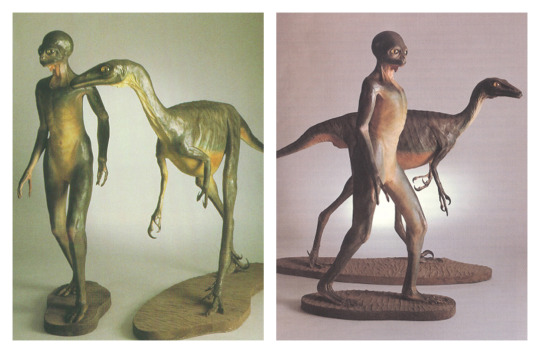
There are two highly-popular, vexing questions about dinosaurs: What would the world look like if these strange and majestic animals had not gone extinct? And, would they ever evolve into intelligent species comparable to humans? In 1982, palaeontologist Dale Russell, after observing “… a general trend toward larger relative brain size in terrestrial vertebrates through geologic time, and the energetic efficiency of an upright posture in slow-moving, bipedal animals”, postulated the Dinosauroid, a humanoid, erect-gaited sophont which may have evolved from Troodon-like dinosaurs had the end-Cretaceous extinction not occurred.

This question occupied the minds of yours truly (seen here on the right), and world-building comic genius Simon Roy (on the left), as well. We were unconvinced by Russell’s Dinosauroid. We thought that an erect, humanoid sophont was too prejudiced towards humans to be realistic. We were instead inspired by zoologist Darren Naish’s writings on the evolution of intelligent, bird-like dinosaurs: “No, post-Cretaceous maniraptorans wouldn’t end up looking like scaly tridactyl plantigrade humanoids with erect tailless bodies. They would be decked out with feathers and brightly coloured skin ornaments; have nice normal horizontal bodies and digitigrade feet; long, hard, powerful jaws; stride around on the savannah kicking the shit out of little mammals; and in the evenings they would stand together in the trees, booming out a duet of du du du-du, a deep noise that would reverberate for miles around…”
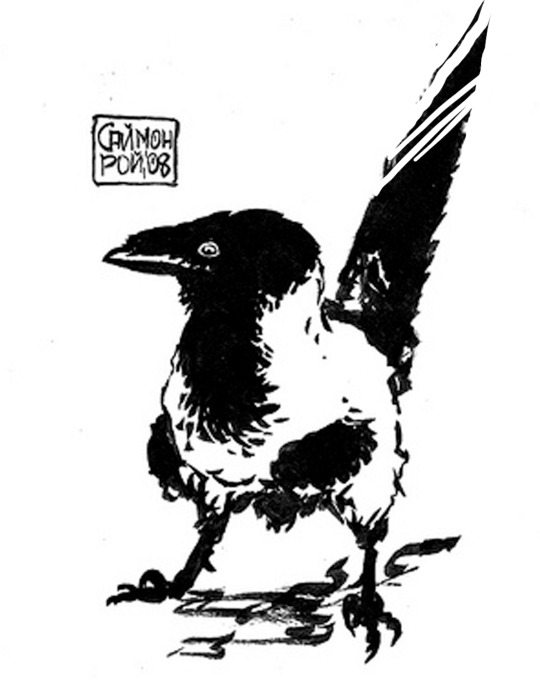
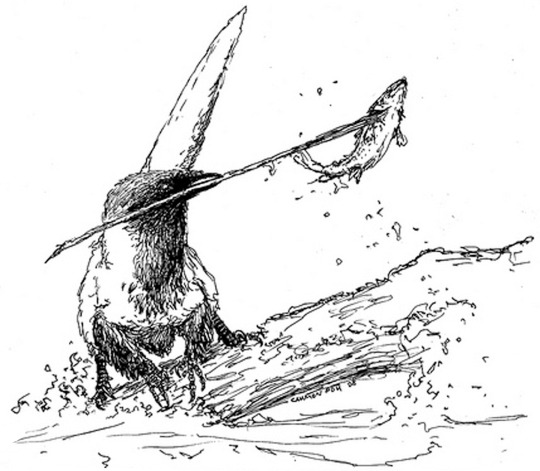
Towards the end of the ‘00s, Simon Roy and I independently began to develop our concepts for bird-like intelligent dinosaurs. Inspired by the ravens he saw around his Canadian home, Simon drew the corvid-like dinosauroids seen above.
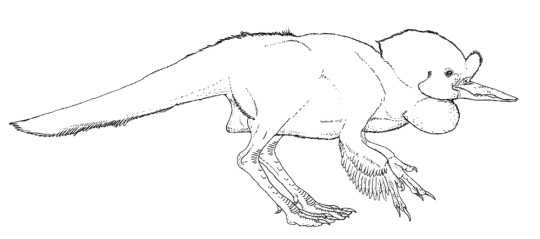
I, in turn, was inspired by ground hornbills, parrots, certain dinosaurs and corvids, and came up with the speculative organism seen above. I named it Avisapiens saurotheos.
Simon and I soon got in touch with each other; and started developing a world and a storyline for our dinosauroids. Our collaborative efforts continued, on-and-off, until the mid-2010s. Our aim was to develop the Dinosauroids story into an illustrated story-book, which we naively hoped to sell to a major sci-fi publisher. But we soon realised that we enjoyed world-building more than writing a story, or putting a book together. We kept bouncing concepts back and forth, but never had a chance to publish them, until now. Most of the body of work you see on this page was drawn by Simon, based on ideas we created together. I also contributed some of the “cave drawings” and certain creature illustrations. This is the first time the totality of our Dinosauroids-universe works has been displayed online.
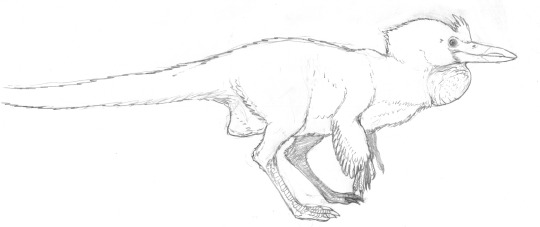
Simon and I refined the design of my original Avisapiens dinosauroid…
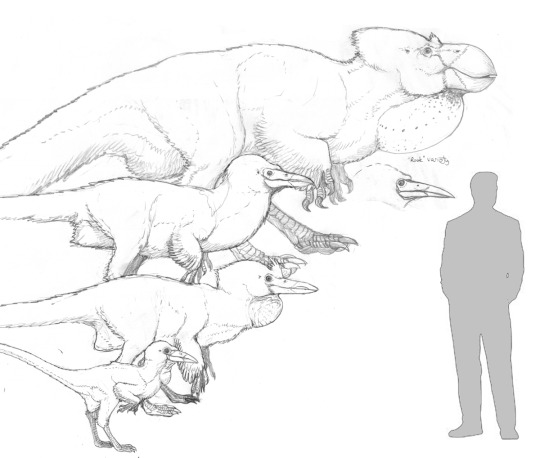
And created a few more sentient races to accompany them. There was one more, slightly-crow-like species of Avisapiens (a continuation of Simon’s corvid dinosauroids - Avisapiens tataricus). These two species were joined by a variety of “forest giants” (Gigantosapiens borealis), and a race of pygmies (Avisapiens minimus).
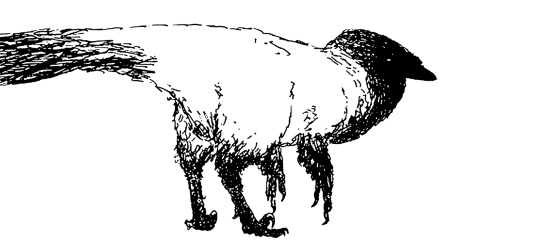
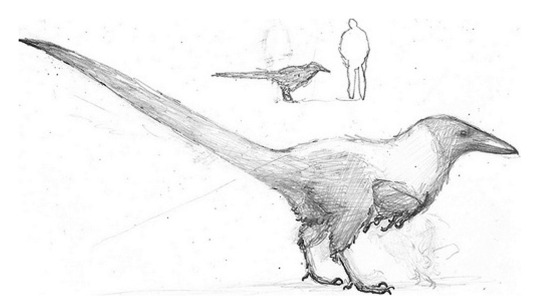

Simon’s refined studies of corvid-like, and pygmy dinosauroids.
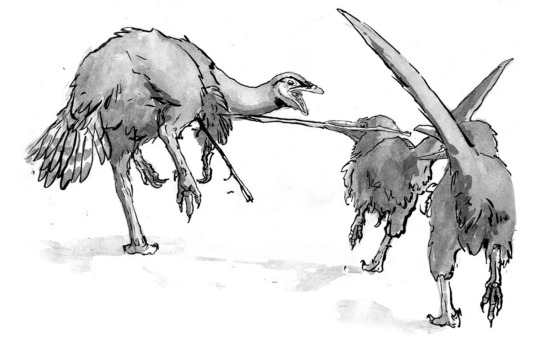
We also designed an extensive selection of animals around our dinosauroids. We predicted that even without the K/T mass extinction, dinosaurs and other animals would have kept on evolving, and many “familiar” groups of dinosaurs would have gone extinct. We thus designed a world where the majority of surviving dinosaurs were the descendants of “maniraptoran” groups; birds, deinonychosaur (“raptor”) dinosaurs, troodonts, oviraptors and therizinosaurs. Here, you can see two boreal dinosauroids using mouth-spears to hunt herbivorous troodont quarry.
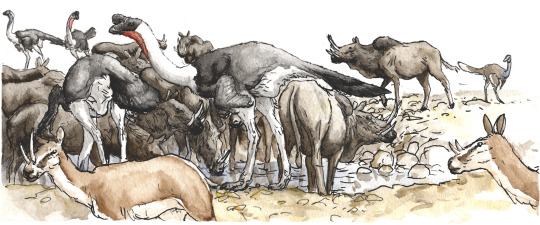
We also did not want this world to be devoid of mammals. Even during the age of dinosaurs, certain mammals evolved into large and sophisticated forms. We envisioned a world where parallel groups of mammals, similar to, but phylogenetically distinct from today’s forms, co-evolved alongside the dinosaurs during their continued reign. The scene above shows an Eurasian water-hole crowded with two species of ornithomimid herbivores (Rugocursor, left-centre; and Cyanogularia, far right); alongside robust (Afrotuberculocamelus) and gracile (Odontocervoides) species of herbivorous mammals which, for the lack of a better term, we decided to name “supermaras”.

A series of studies showing the evolution of supermaras from rodent-like multituberculate mammals. The species depicted here is Ceratomegamys.

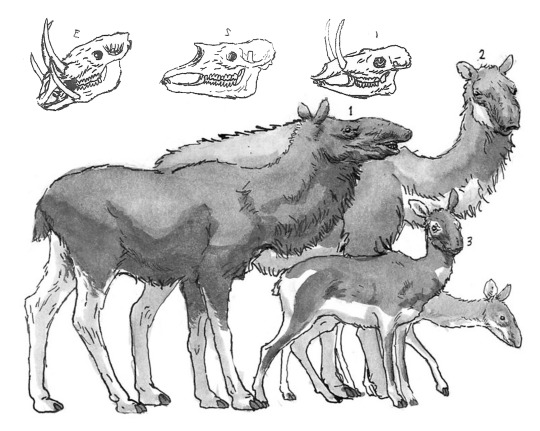
The full diversity of cursorial “supermaras”, from left to right: The burly, tusked Odontobovis; the superficially-camel-like Tuberculocamelus; the gazelle-like Odontocervoides; the trunked, moose-like Pseudalces; and the two related forms - the big, desert-dwelling Macropseudalces; and one of the many deer-like Cervopseudalces species.


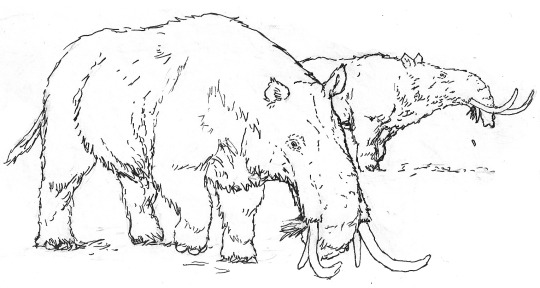
Studies of Megatapirus, large, superficially-elephant-like mammals that live in far-northern climates.


We also derived a variety of mammalian carnivores, mostly from marsupial stock. Through the honing forces of evolution, we imagined some would look very similar to the canid predators we have in the present day - the actual difference would only be in their internal and reproductive anatomies. Above, clockwise: The large, badger-like Mephitursoides; the extremely dog-like Pseudokynos; the hyena-like Krokutadasyurus.

Some marsupial predators diverged from the mammalian body-plan, and evolved into forms roughly converging with the predatory dinosaurs. The raptorial, meat-eating kangaroo-equivalent Theropodoktonos and kin are potent predators in South America.
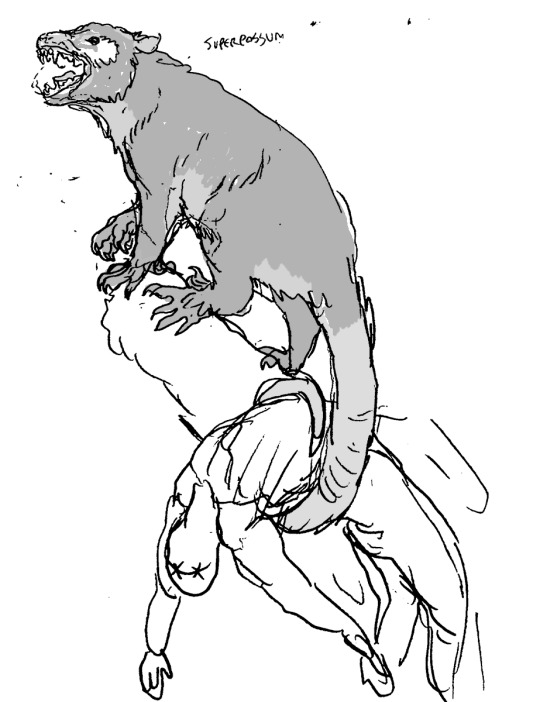

Two more divergent marsupials: The leopard/possum Phobodidelphyoides; and the monkey-like Marsupiolemuris, a social, arboreal form with a potential to evolve intelligence.

We also wanted to have flying reptiles - pterosaurs - still alive and kicking in our world. These extraordinary animals were already in decline by the time dinosaurs became extinct. So we relegated them to only a few roles, comparable to storks and other large water-birds alive today. Above is a flock of Diluvipterus; large, filter-feeding pterosaurs. Also note the solitary duck flying on the upper-left corner.
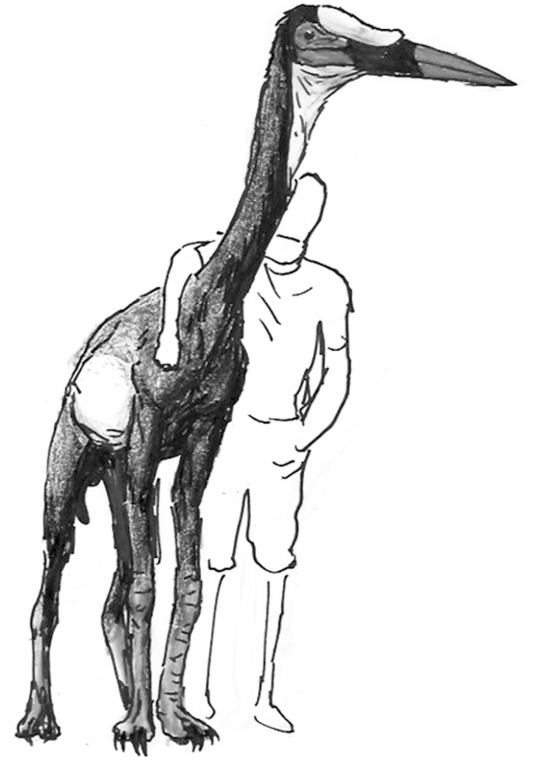
Another, flightless pterosaur, Cygnotherium, from the islands that now make up New Zealand.


A more unusual group are the avisuchians, descendants of maniraptoran dinosaurs that secondarily converged on the aquatic bodyplans of spinosaurs (which are now extinct in this timeline). Most resembled the short-tailed forms, Pisciraptor and Brachyornithoides seen above. These goose-to-dog-sized animals inhabit rivers and lakes, and occupied a niche comparable to otters today.

There were also long-tailed Avisuchians such as the Natatoraptor seen above. These animals inhabit open waters, and nested in estuaries and beaches.

A contemporary scene from Eurasia shows commensal life between mammals and dinosaurs. Two Pseudalces browse peacefully alongside two kinds of large ornithominids, Archganseria and Brontonyx. A tiny, heron-like troodont, Anatolocursor, can be seen between them, looking for small animals flushed out by the large herbivores’ movements.

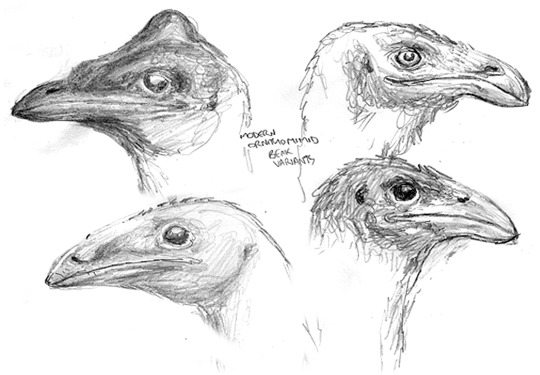
Nevertheless, despite co-existing with large mammals, dinosaurs are more diverse on this world. Herbivorous dinosaurs, such as these derived ornithomimids, constitute a large part of dinosaurian diversity. Above left are studies of Ganseria, a common, medium-sized browser. Above right, clockwise from the top right, are portraits of Ukkuloganser, another medium-sized browser; Nyctodromon, a nocturnal digger; Adzuganser, a small omnivore; and Pyramidoganser, a crested form native to the Nile Delta.

A scaled study of Brontonyx, a heavyweight ornithomimid herbivore.

Portraits of many cursorial dinosaurs from across Eurasia:
1- Leptoganseria, a mountain-dwelling ornithomimid browser found on the mountains of what is now the Caucaus.
2- Ikiridectes, a troodont that mostly hunts small digging mammals.
3- Aktardektes, a small ornithomimid that has specialised for cracking hard-shelled nuts.
4- The gracile, juvenile variant of Brontonyx, (6) which occupies a completely-different ecological niche as a generalist omnivore.
5- Rugocursor, a widespread, broad-beaked ornithomimid with many species, common across North Africa and Eurasia.
6- The adult form of Brontonyx, a gigantic ornithomimid that feeds on trees, and defends itself with heavy claws.
7- A vulture-like Cynornithoides, an extremely bird-like troodont, a frequent commensal of Avisapiens and related intelligent species.

A variety of Rugocursor, a mostly-herbivorous ornithomimid with adaptations for running.
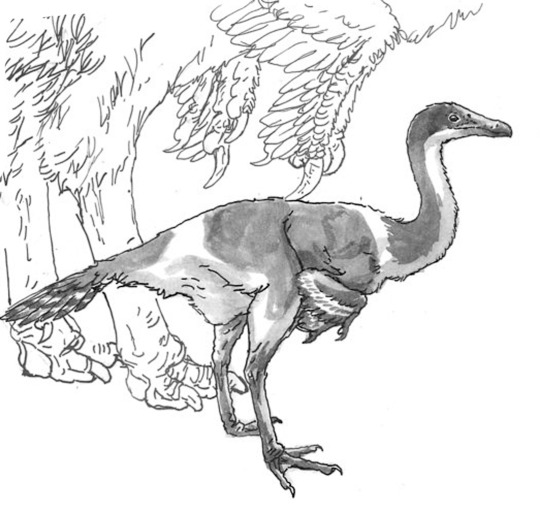
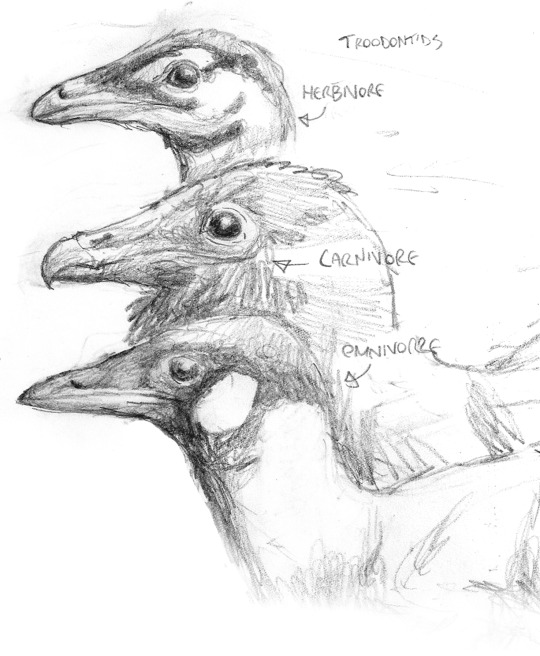
Various troodonts, small-bodied, sometimes very bird-like omnivorous dinosaurs, distantly related to the Avisapiens lineage. Left, shaded study of Variocursor, a common, heron-sized, striding predator on small animals. Right, from top to bottom; Vuuria, a herbivorous form common across Eurasia; Boreocursor, a cold-climate predator, related to the Variocursor seen on the left; and Paravuuria, an omnivorous form.


The last descendants of hadrosaurs, the famous “duck-billed dinosaurs”, still roam in South America. The hoofed, sheep-sized Ornimastax seen above left, is a typical example. Australia, as in our world, is home to an unusual radiation of forms whose relations to animals on other continents are not very clear. Brachygullagong, seen above right, is a troodont-like form whose duck-like skull and batteries of grinding cheek teeth have secondarily converged with those of the hadrosaurs.

The largest herbivores on this world are long-necked, scythe-clawed ornithomimid relatives known as avititans. The largest species on Eurasia is Avititan bicolor, seen above in scale with a human figure.
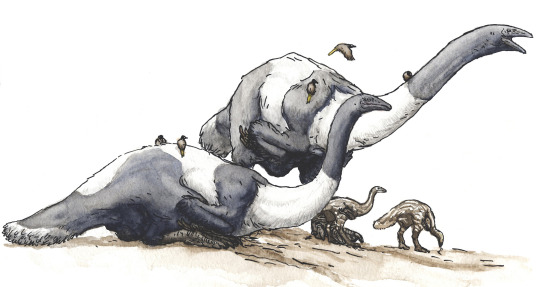
Avititans owe their ecological success to their strong social structures and their care of their young. Here are two Eurasian avititans with their offspring. Yellow-tailed enantiornithine tick-birds, Parasitophagus leucurus, can be seen on their backs.

Oviraptoriformes made up another important clade of dinosaurs in this world.

Descended from bird-like ancestors, various clades of these animals live on as important omnivores, scavengers and even predators in many ecological niches. Above is Eblisornis, a common species found throughout Eurasia.
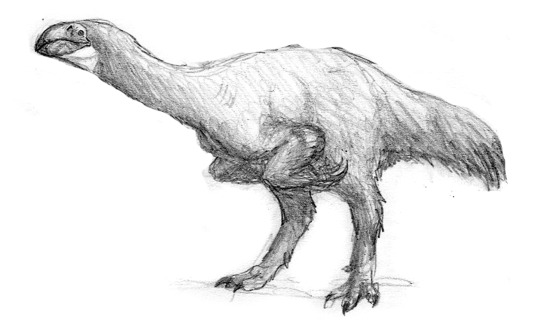
The bull-bird, Bosornithoides erythrops, is the largest and most prominent oviraptoriform on the Eurasian continent. It subsists mostly on plants and fruit, but will eat carrion if given the chance.
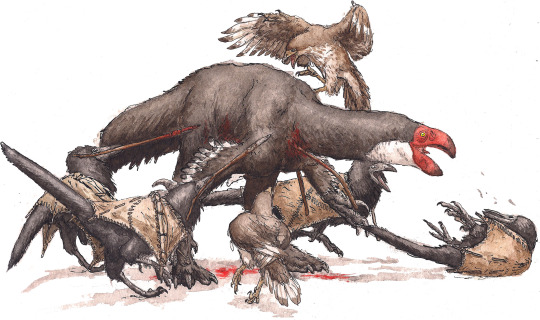
Hunting the wary and dangerous Bosornithoides is an important rite of passage for dinosauroids. The animals require coordination and group-work to bring down, and hunting one is a bonding experience for batches of young-adult nestmates. This ritual not only cements the dinosauroids’ social standing in their tribe, but also bonds the hunters together for the rest of their lives. The four hunters-to-be in this picture are accompanied by a couple of jackal-birds (Cynornithoides), domesticated pets that are almost as smart as the dinosauroids themselves.
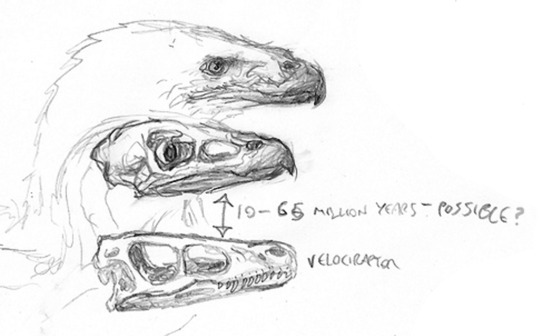
Many dinosaurs dabble in carnivory, but the main predatory niches on this version of Earth, are occupied by a diverse radiation of paradromaeosaurs, descendants of the famous “raptor” dinosaurs and kin. Paradromaeosaurs have diverged considerably from their ancestors. One lineage, known as the rhynchovenators, replaced their teeth with sharp, raptorial beaks.
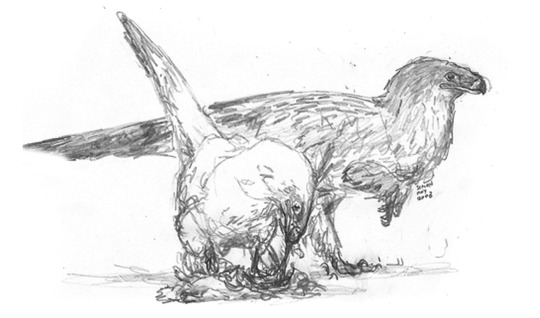
The male and female of the common boreal rhynchovenator, Rhynchovulpes agilis.

A lean-legged Egyptian rhynchovenator, Rhnychovulpes aegypticus, atop a dead multituberculate mammal. The key to rhnychovenators’ success is their added tenacity and stamina. Even a small rhynchovenator can overcome comparatively large prey by continually harassing and chasing it into exhaustion.

The bald-headed Osteophaganax regalis is a common scavenger encountered across the Caucaus Mountains. Its males develop striking, black-and-purple wattles on their faces during spring.
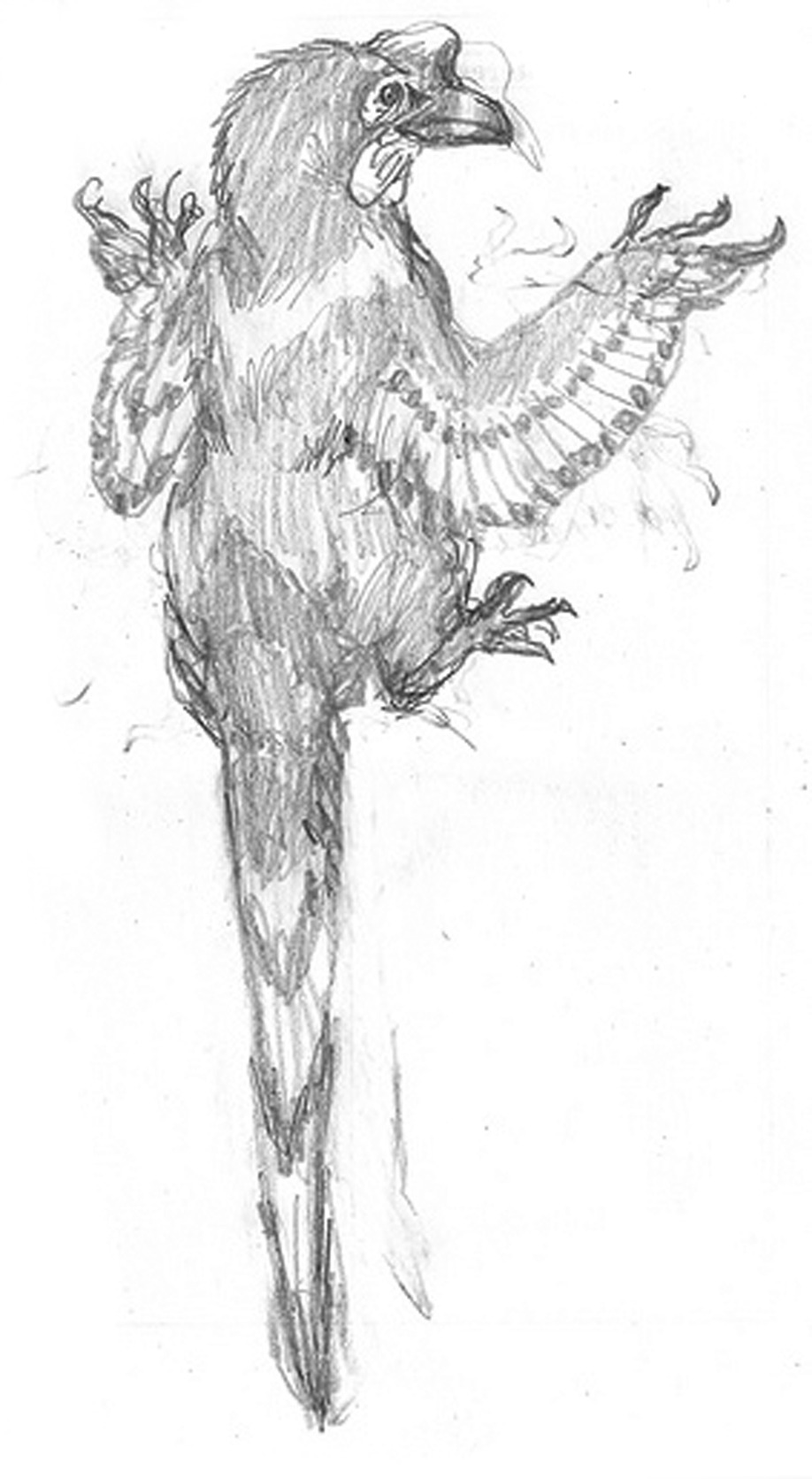

Two more derived troodonts. Left, a tree-dwelling arbosaur, Toucanops dixoni, from one of the diverse and little-understood clades found across the South American continent. Right, the lean, narrow-beaked Halophagus sp. from fossil deposits in what is now China. This group evolved specialisations for marine diving and probably saltwater drinking, before becoming extinct during the Miocene.
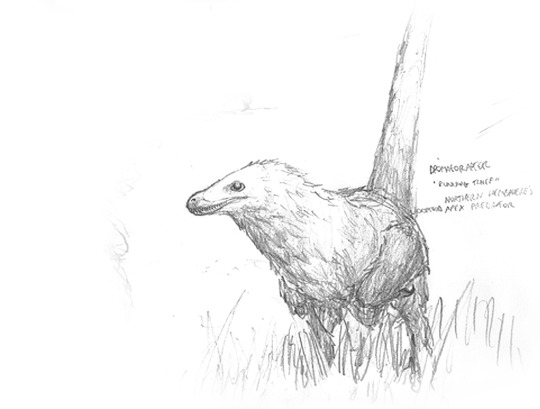
The dominant guild of maniraptoran predators, the tyrannoraptors, evolved from “regular” dromaeosaurs with powerful, biting jaws. Some species living today, such as the Savannahdromeus shown above, are still very similar to the earliest forms. Despite its small size, the smart and social Savannahdromeus are apex predators thanks to their pack-hunting behaviour.

Another basal tyrannoraptor, Pantherdromeus - is a solitary hunter that is common across much of Eurasia. It probably represents a diverse and subtly-variable species complex.

Solitary, basal tyrannoraptors eventually gave rise to the terrifying main-line tyrannoraptors in the last twenty-million years. The evolution of these animals was marked by the reduction of their wings and the enlargement of their legs, and jaws. Their tails developed into stiff and rod-like balancing organs. In some respects, they were the evolutionary echoes of the big-jawed, running tyrannosaurs, which had become extinct earlier on, during this world’s version of the Eocene period. Unlike tyrannosaurs, however, tyrannoraptors had well-developed social behaviours and intelligence; which, when coupled with their fast speed and terrific jaws, turned them into formidable apex predators. Above are the adolescent and mature forms of Metadromodaemon phobetor, a mid-sized hunter found in the Middle East and North Africa.
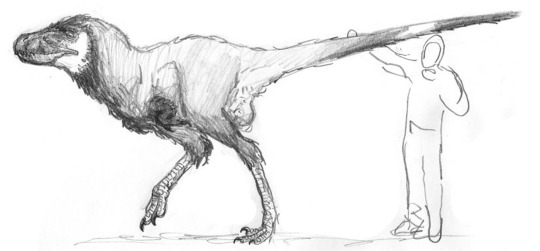
A scaled drawing of Wotandromeus bicolor, the terrifying, large-headed hunter of European forests.
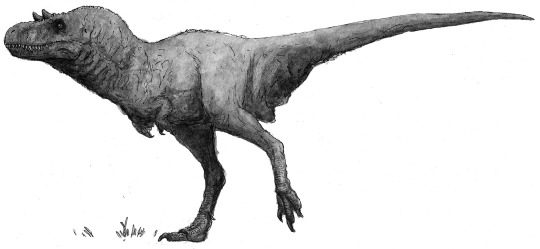
The seven-metre-long Melanorodromeus euceratus - also known by the Dinosauroids as “black thing” - is the largest predator on mainland Eurasia; but even larger forms are reputed to exist in Siberia and North America.

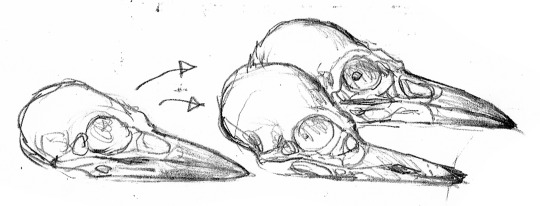
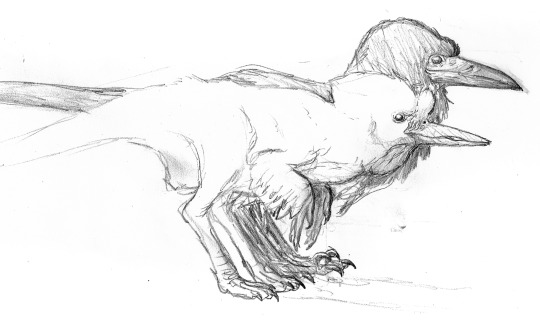
Let us now return to the Dinosauroids, their culture, and art. Above is a brief study illustrating the divergence of the two species of Avisapiens; A. saurotheos and A. tataricus, from ancestral eu-troodontid stock.


Especially A. tataricus shows considerable variation in beak shape, length and colouration. Above, right are the colouration of the Eurasian (top right, bluish-black), and Northeast Siberian (above right, yellowish-brown) races. Above, left shows a spectrum of variation in A. tataricus beaks. The cross-beaked and long, curved beaks occasionally crop up in certain bloodlines, which also have augmented song-memories. These individuals are revered as shamans in certain A. tataricus tribes; or are immediately killed-off as harbingers of doom in others.
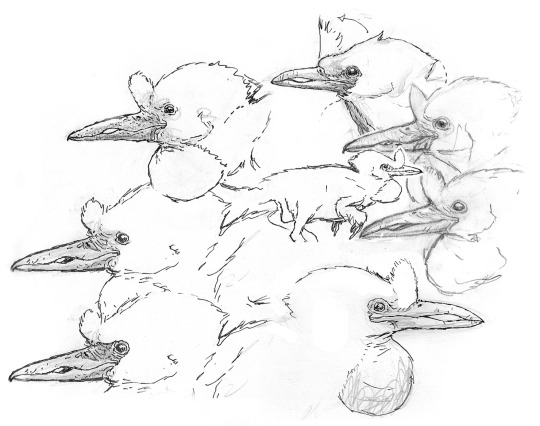
Above, the extensive variation in the head shapes, beak lengths and crests of various races in A. saurotheos. The bottom-right sketch depicts a hybrid individual between A. saurotheos and A. tataricus.

A powerful hunter of A. tataricus, from the Carpathian Mountains, showing a stone axe and bent spear that are characteristically used by this particular tribe.
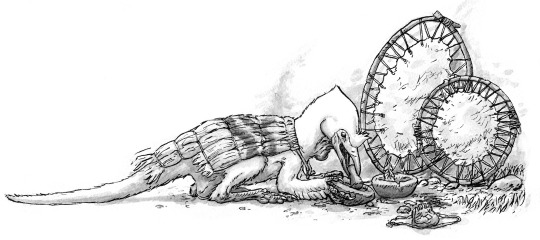
An artist/shaman of one of the settled A. saurotheos tribes living around the Balkans. He paints on animal skins stretched taut across circular frames, and paints using ground-up soil and other pigments, wielding a brush made from a wing-feather. The skin canvas also double as drums.
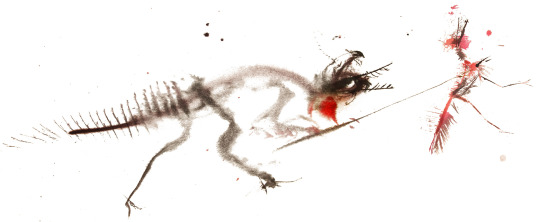
Art is one sure-fire way of identifying an intelligent species. This skin-painting shows a spear-hunter and prey, a painting by the aforementioned shaman.

Painting of a god or hero-figure with red tail feathers.
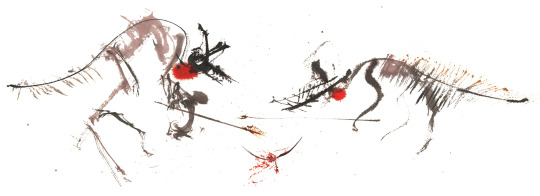
Painting of two shamans divining the future from the entrails of a dead flying animal.
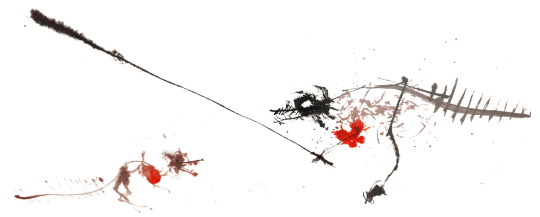
Painting of a hatchling being trained by a village elder.
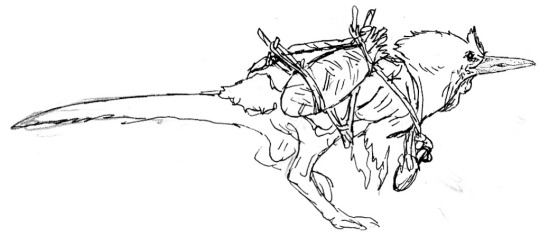

Studies of an A. saurotheos wanderer with a travel harness; and a duo of A. tataricus migrants with a domesticated bull-bird, a relative of the oviraptoriform Bosornithoides mentioned above.
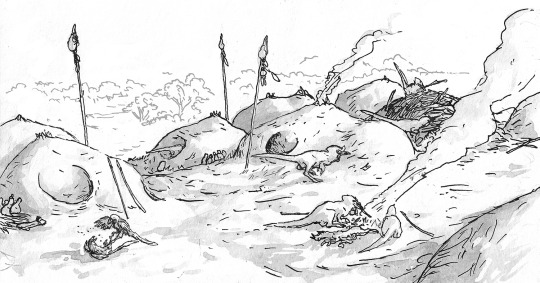
The view from an Avisapiens saurotheos village, showing the species’ characteristic nest-houses, and a pair of semidomesticated Cynornithoides jackal-birds playing in the village square. Note the heads mounted on tall poles, a sign of reverence to the spirits of the departed.
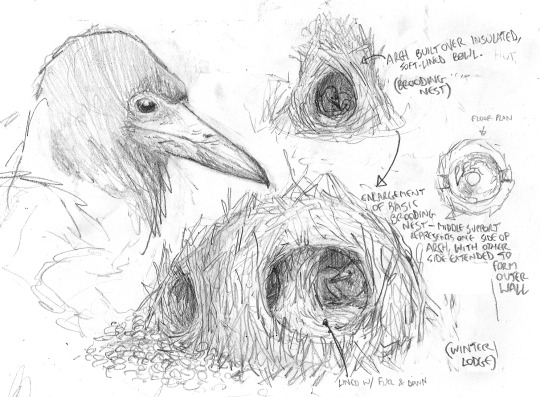
Detail of a brooding nest constructed by Avisapiens tataricus. Most tribes of these species are migrants that range across Eurasia, few build permanent structures.

Sketch of an A. tataricus wearing a travois-like travel harness.

Study of an A. saurotheos wanderer with travel gear.
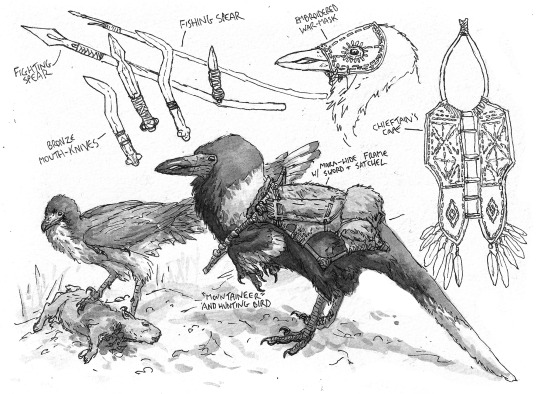
A detailed study of the burly A. tataricus native to the Caucaus Mountains, complete with weapons, travel gear and ornamental cape.

Sketches of war-like A. tataricus tribes native to the Eastern Mediterranean region. These tribes are known for their ferocious (if impractical) war-masks.
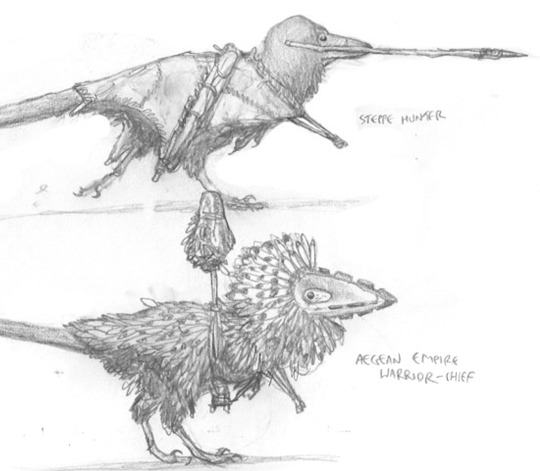
Studies of two different warriors from two different Avisapiens tataricus societies.
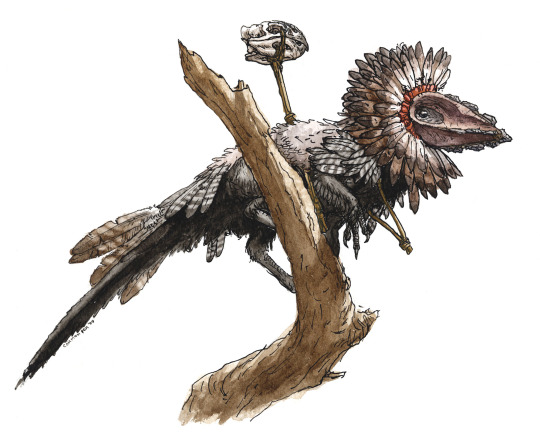
A resplendent A. tataricus warrior from the Levant, wearing an ornate head-dress of feathers, and an obsidian-studded war-mask.

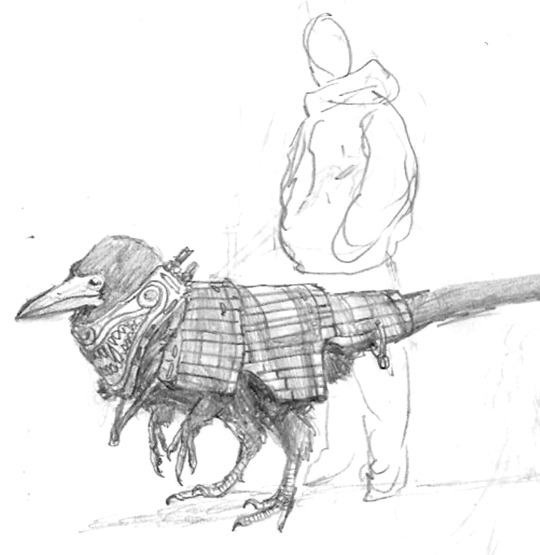
Studies for Avisapiens spear-throwers and wooden-slat armour; from a comparatively advanced period on this species’ societal development.

An A. saurotheos shaman entertains hatchlings with fireside tales of spirits and other worlds.

A band of slave-keeping A. tataricus warriors during a raid to an A. saurotheos village. A young shaman is captured and de-clawed.

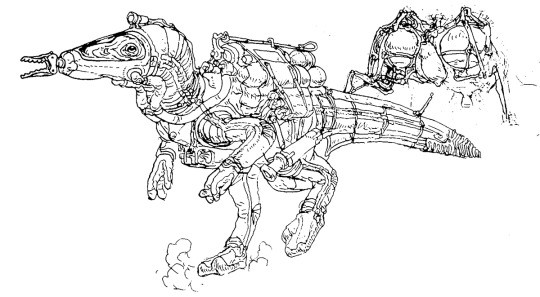
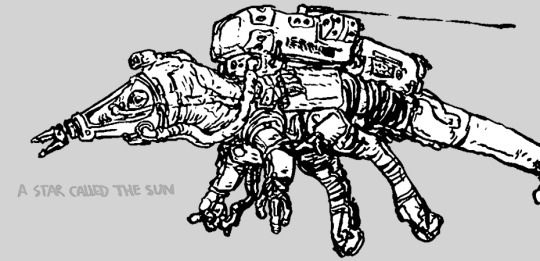
Simon Roy and I also dwelled on the far-future evolution of dinosauroid technology. The sketches above of a “knight”, moon lander and an astronaut were produced, but we did not pursue these scenarios seriously.

Let us conclude our visit to the dinosauroid tangent-universe with one last look at our artist/shaman, his village, and his paintings. Somewhere in deep time, they are still alive, and still waiting to tell us of their adventures.
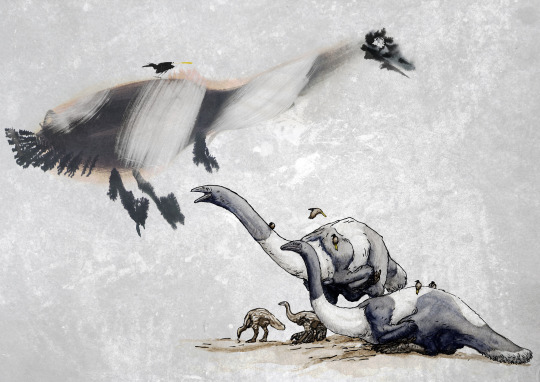
A painting of an avititan family.

A painting of the dangerous, predatory “black thing”.
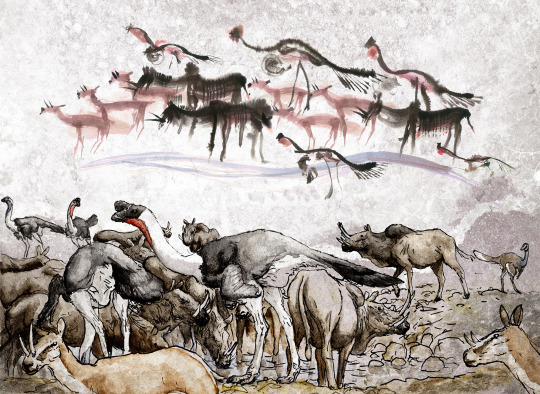
A painting showing numerous animals at a watering hole.

A painting showing an A. tataricus warrior.
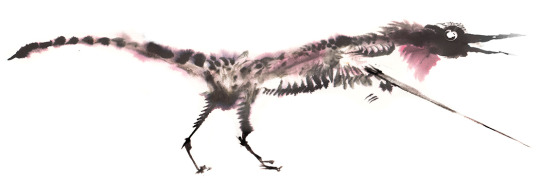

Stylised paintings of spear-wielding Carpathian warriors.

Painting of a ferocious Aegean headhunter.

A stylised painting showing an immature dinosauroid.
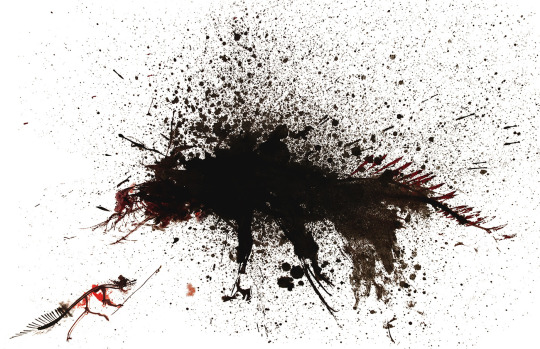
Stylised painting of a warrior confronting a spirit-creature.

Stylised painting of a powerful Caucausian mountain warrior.

Painting showing a ghoul-like oviraptoriform animal.

Painting of one of the sky-gods worshipped by A. saurotheos.
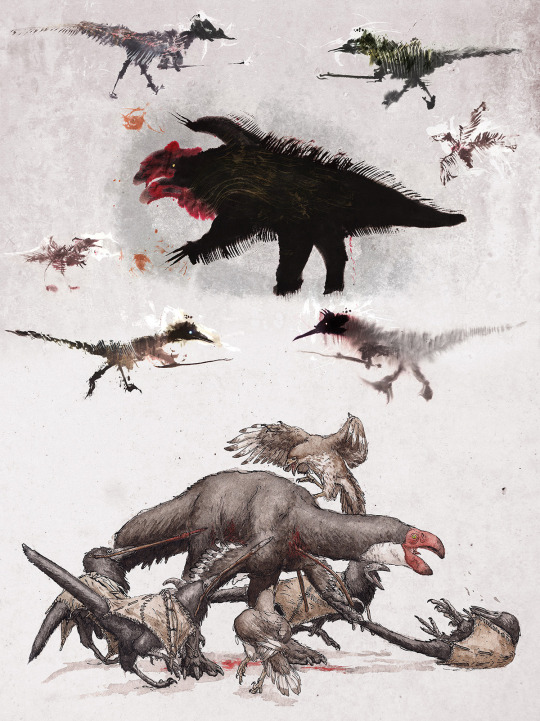
A complex painting showing four A. tataricus warriors hunting a bull Bosornithoides.
Simon Roy and I may return to the dinosauroids universe one day with a real story; but truth be told we enjoyed world-building far more than inventing stories and characters.
- 2008 - 10/2019.
#worldbuilding#speculative biology#speculative evolution#dinosaurs#dinosaur art#dinosauroids#paleoart#creature design#c m kosemen#simon roy
430 notes
·
View notes
Photo

Recipe ideas Part two. This week? CAT FOOD
March 25, 2021
Welcome back to the Cougar Paws for a Cause Blog! I hope you were able to rest and repower after the much needed Spring Break!
Last week on the blog I gave a meal idea for you and your dog that was simple and delicious to make! I understand not everyone owns a dog, so I didn’t want to leave out our cat owners.
Before I share a few wonderful recipes for homemade cat food, lets dive into the main food categories that cats enjoy eating! All this information was found on pets.webmd.com. A very useful resource when it comes to pet safety.
Human Foods that Cats CAN and love to partake in:
1. Meat-“Cats are meat eaters, plain and simple. They have to have protein from meat for a strong heart, good vision, and a healthy reproductive system. Cooked beef, chicken, turkey, and small amounts of lean deli meats are a great way to give them that. Raw or spoiled meat could make your cat sick. If you wouldn't eat it, don't give it to your pet.”
2. Whole Grains: “Many cats like corn, and polenta, a coarsely ground cornmeal, has a good texture for them. You can try brown rice, barley, and wheat berries, but you may need to mash them first. Cats tend to like smaller grains like millet and couscous. Just make sure any grains you give are cooked so your kitty can digest them fully.”
3. Fish: “Fish have a lot of omega-3 fatty acids, which help your cat's eyes stay sharp as well as help with arthritis, kidney disease, and heart disorders. Canned or cooked fish is fine for a treat.”
4. Eggs: “Eggs are another super source of protein for your cat. But make sure they're cooked”
5. Veggies: Not popular amongst cats but “they are a rich source of vitamins, and they're loaded with fiber and water to help with digestion. Try fresh cucumber or cantaloupe, steamed broccoli, or asparagus.”
6. Cheese: “Cheese is a high-protein snack that's fine for your cat in small amounts”
Human Foods that Cats CAN’T partake in:
1. Chocolate
2. Grapes and raisins
3. Onions and garlic
4. Macadamia nuts
5. Bread dough
6. Alcohol
For more information you can visit this page about Cat Food Safety:
https://pets.webmd.com/cats/ss/slideshow-people-foods-cats-can-eat

Alright lets get into some homemade cat meal recipes!
The recipes for today were created by Blogger Franny Syufy from The Spruce pets Blog!
Cat Breakfast
Ingredients:
· 1 tablespoon nonfat dry milk
· 3 medium eggs
· 3 tablespoons cottage cheese
· 2 tablespoons veggies (grated)
Instructions:
· Mix together the milk powder with a small amount of water.
· Add the eggs and beat well.
· Pour the mixture into a small non-stick frying pan and cook on medium-low heat until done.
· Flip over like a pancake and spread the cottage cheese and veggies over half of the cooked surface. Fold like an omelet. Cool and cut to bite-sized pieces to serve.
Chicken Meal
Ingredients:
· 1/2 pound chicken breast (boneless, raw weight, cooked)
· 1/2 large egg (hardboiled, split it lengthwise)
· 1/2 ounce clams (chopped in juice)
· 4 teaspoons canola oil
· 1/8 teaspoon salt substitute (potassium chloride)
· 3 bonemeal tablets (10-grain or equivalent)
· 1 multiple vitamin-mineral tablet.
Instructions:
· Chop the chicken breast and egg.
· Crush the bone meal and vitamin tablets finely, then combine all ingredients.
· Refrigerate, then warm slightly before serving.
Thank you again to Franny Syufy for creating and sharing these nutritious and delicious cat food recipes!
I’ll see you guys next week with a fun post about Dog and Cat Fashion!
Cover Picture by Wojciech Kumpicki on Pexels.
2 notes
·
View notes